
Welcome to the Deeto Hub
A resource and community space for modern marketers, sellers, and builders using customer voice to grow — together.

A resource and community space for modern marketers, sellers, and builders using customer voice to grow — together.
This hub is built for anyone who wants to do more with the voices of their customers. Whether you're scaling advocacy, building trust with proof, or rethinking how to go to market — you're in the right place.
How-to guides and playbooks for building with customer voice
Campaign-ready templates and swipe files
Benchmark reports and reference best practices
Event recordings, expert sessions, and community spotlights
Ask questions. Share ideas. Trade wins. This is your space.
You don’t have to figure this out alone. The Deeto community connects you with other leaders using customer voice to build better GTM motions, faster-growing brands, and smarter strategies. If you are interested in joining when it launches, sign up below.
Automate advocacy management workflows
Dynamically generate customer stories and social proof
Eliminate manual reference management
Track and report advocacy impact on revenue
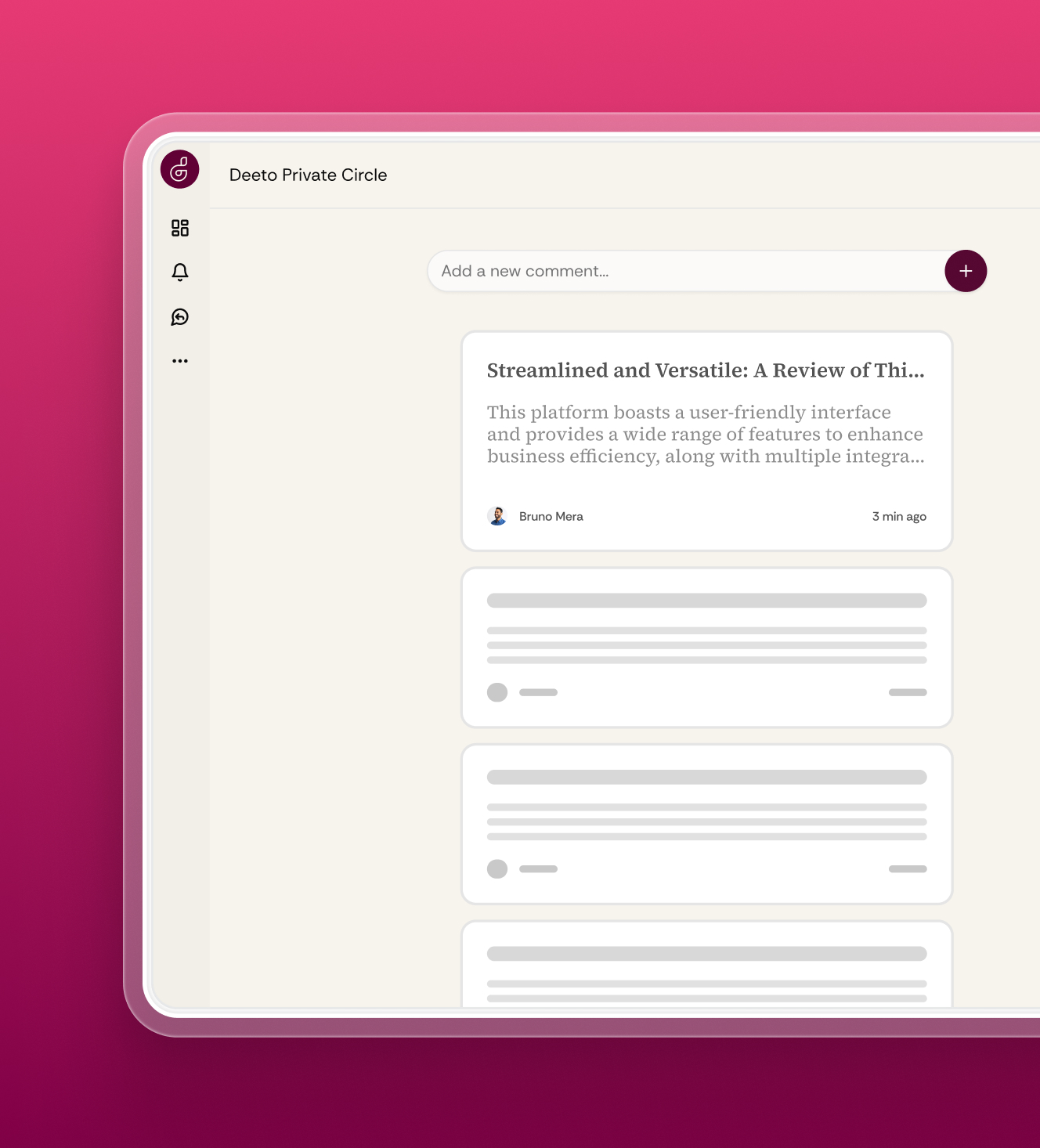
Discover practical guides, templates, and tools to help your team close more deals, faster.
People don’t trust brand-generated content the way they used to. You can say “we’re the best” a hundred times, but it won’t carry the same weight as a real user saying it.
B2B buyers are doing more research, reading more reviews, and relying more on recommendations from peers. They want to hear from people who’ve actually used your product, not a sales team with a script.
That’s why referral marketing is one of the most powerful growth levers in B2B. When done right, it brings in leads that close faster, stick around longer, and convert at higher rates.
Let’s break down how you can build a referral program that works.
B2B buyers are overwhelmed. Their inboxes are packed with cold pitches, retargeting ads, and 30 different vendors who all claim to be “innovative” or “disruptive.”
Referrals cut through that noise. When a user from the same customer segment can speak to your product's value, it bypasses the skepticism, the endless comparison-shopping, and the over-polished sales decks.
And the numbers back it up:
Yet only 3 in 10 B2B companies in North America have a formal referral program in place.
That’s a huge opportunity. Especially considering the fact that referrals bring in high-quality leads that don’t need as much nurturing, already trust your brand, and are far more likely to convert.
Before you launch a B2B referral program, you need a solid foundation. That means aligning your team on what success looks like, who you’re targeting, and how you’ll measure impact. Without that clarity, even the most well-designed program will fall flat.
“Getting more referrals” sounds like a goal, but it’s really just an outcome. You need to define the specific business objective your referral program supports.
Start by asking: What larger initiative is this supporting? For example, if your Q3 OKRs include breaking into mid-market accounts, the referral program should be built to source leads from existing SMB clients who know contacts at larger companies.
Then, define what success looks like (with metrics). Are you aiming for 10 referred leads per month? A 20% referral-to-close conversion rate? An X% increase in deal velocity? Pick 1–2 primary KPIs and get buy-in from sales, marketing, and CS on what’s realistic.
Pro tip: A good referral rate generally falls between 2% and 5% of your total customer base, so you can start there.
Spoiler alert: it’s not always your best customers. Some love your product but don’t have a strong network. Others are well-connected but haven’t been nurtured enough to feel motivated to share.
Start with segmentation. Use your CRM or success platform to filter customers by Net Promoter Score (NPS) or CSAT, length of time using your product, product usage patterns (especially power users), and industry influencers or highly networked roles (consultants, agency partners, VCs).
Then, look for referrer intent signals. If someone already referred you organically (check email intros or LinkedIn mentions), gave you a positive review or testimonial, or engages with your brand regularly (e.g., social shares, event attendance), they should be at the top of your list.
From there, you'll be able to build a referrer "persona" based on things like job title and industry, their network access (e.g., “sells to our ICP” or “works at adjacent orgs”), and their motivation (status, rewards, helping others succeed).
If you really want to be proactive, your next move is figuring out who these people know and how those connections line up with your target accounts. There are a few different ways to do this, but the easiest way to start is with LinkedIn Sales Navigator.
Search by current and former employees of your target accounts, and cross-reference those with your referrer list. You’ll often uncover hidden warm paths, like a power user who’s connected to 5 decision-makers at a dream logo. Message your advocate and suggest a friendly intro.
You should also train your CSMs and AEs to spot mapping opportunities by asking simple questions like:
When you have a strong pipeline of referral leads coming in, everybody wins. Your sales team spends less time convincing and more time closing. Your CS team gets higher-quality accounts. And you'll see a higher ROI on your marketing content.
Here’s what a well-run B2B referral program can do for your business:
Not to mention, every successful referral plants the seed for more. You’re not just acquiring a new customer, you’re potentially gaining another advocate. Over time, the program builds on itself, which further reduces your dependence on outbound or paid.
There are five main ways to get B2B referrals:
As you build your referral program, you may use some or all of them.
These are the most common (and easiest to implement) types of B2B referrals. User referrals focus on activating your existing customer base to bring in new business, usually through a one-to-one, personal introduction. These programs typically offer incentives for both parties (the referrer and the referee) and rely on the trust that comes from a direct, human connection.
They work best when:
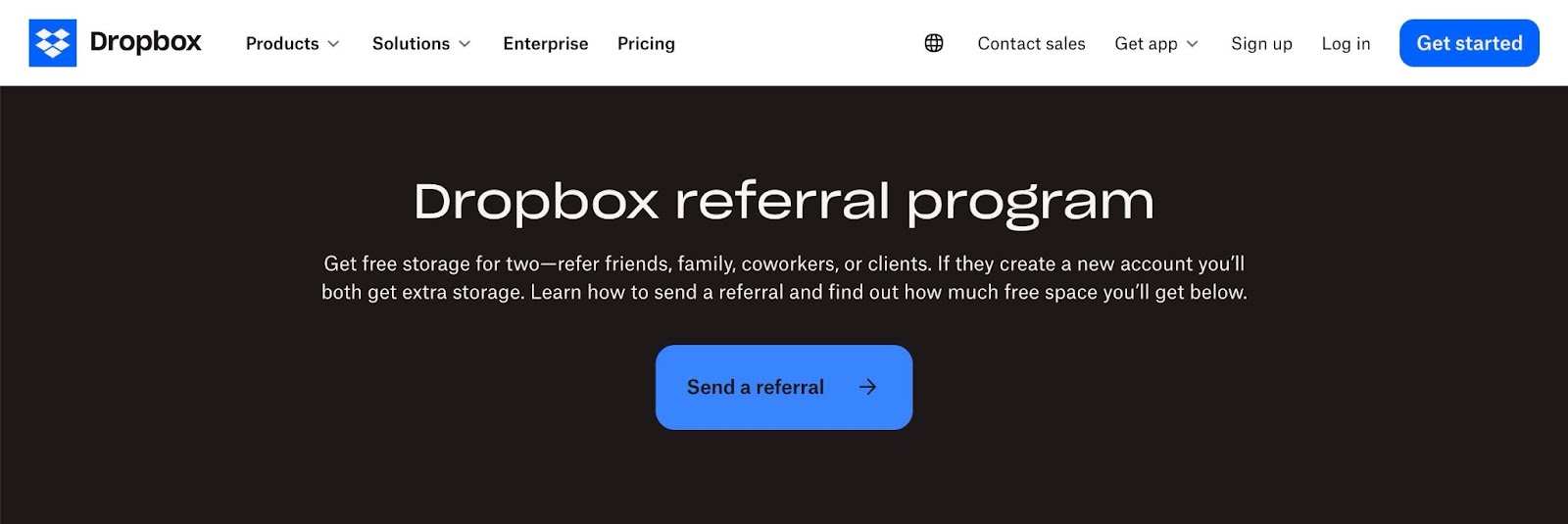
Dropbox was one of the earliest companies to perfect user referrals at scale, even in the B2B space. And it netted them 3,900% user growth in its first 15 months.
Its business-tier users are encouraged to share their unique referral link with coworkers or other businesses, earning additional storage space or service credits in return. The offer is simple, the onboarding is seamless, and the value to both sides is immediate.
Affiliate referral programs reward third parties — creators, consultants, agencies, or influencers — for sending traffic or leads your way. Unlike user referrals, affiliate programs scale through content, SEO, and outreach. The incentive is usually monetary and tied to performance: clicks, sign-ups, or closed deals.
They work best when:
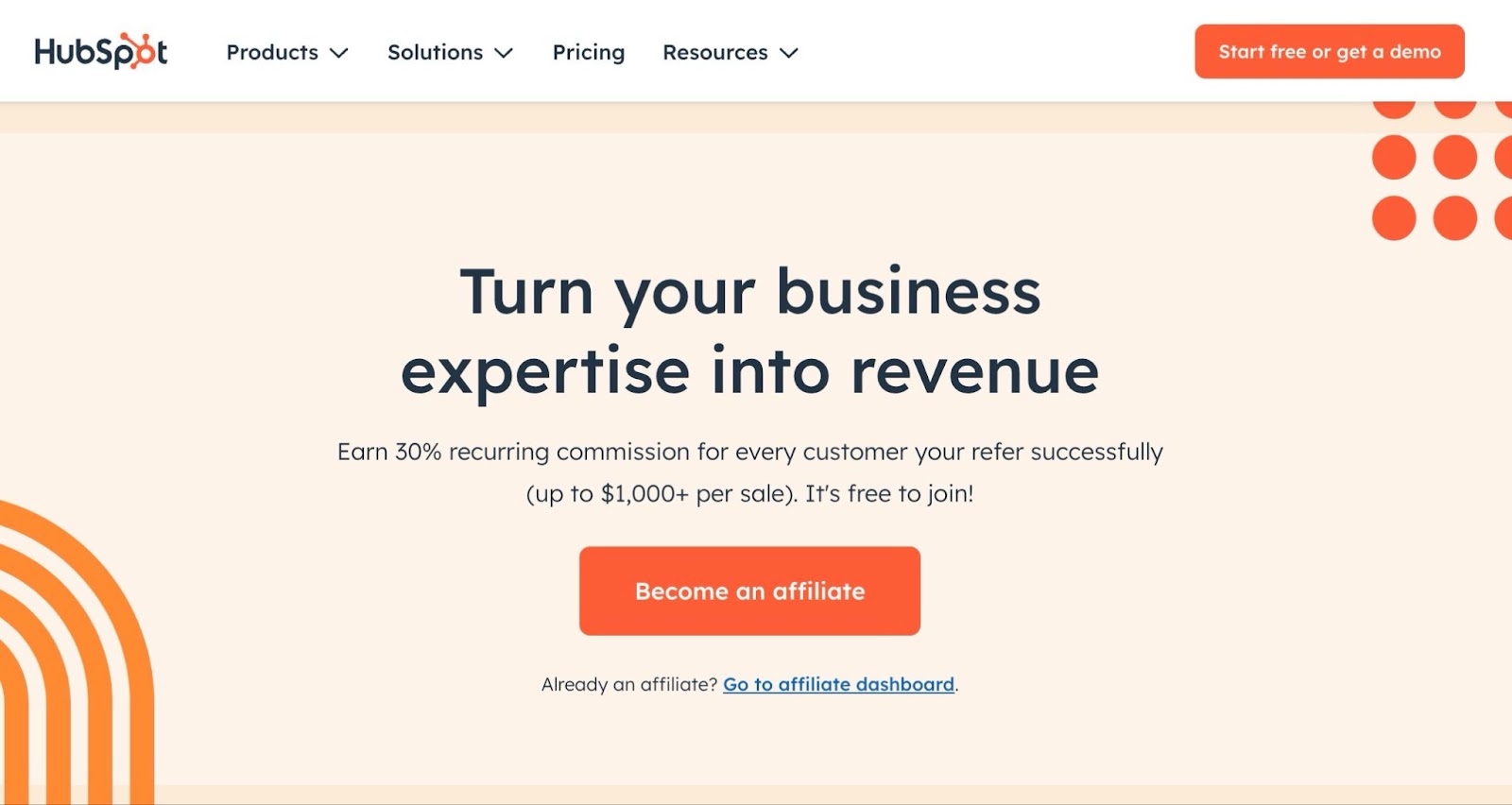
HubSpot offers affiliates generous commissions (up to $1,000 per product purchase) for promoting its suite of marketing, sales, and CRM tools. Their program includes a portal with tracked links, branded assets, and performance reporting. Through content creators, review sites, and consultants, HubSpot turns external audiences into a powerful top-of-funnel engine.
Influencer referral programs involve partnering with niche thought leaders, industry experts, or high-trust creators who have influence over your ideal buyers. These people are consultants, analysts, newsletter authors, or LinkedIn personalities whose audience listens when they recommend a tool or service.
These work best when:
Notion has quietly built a network of productivity influencers and creators, many of whom consult with teams on how to structure internal documentation and project management. Instead of just paying for shoutouts, Notion empowers these influencers (who are also their own power users) to teach others how to use the product, refer enterprise teams, and even sell their own templates.
Value-added referral programs tap into partners who already have trust-based relationships with your target customers—think resellers, service providers, consultants, system integrators, and tech partners. These partners refer your product because it makes theirs more complete.
These work best when:
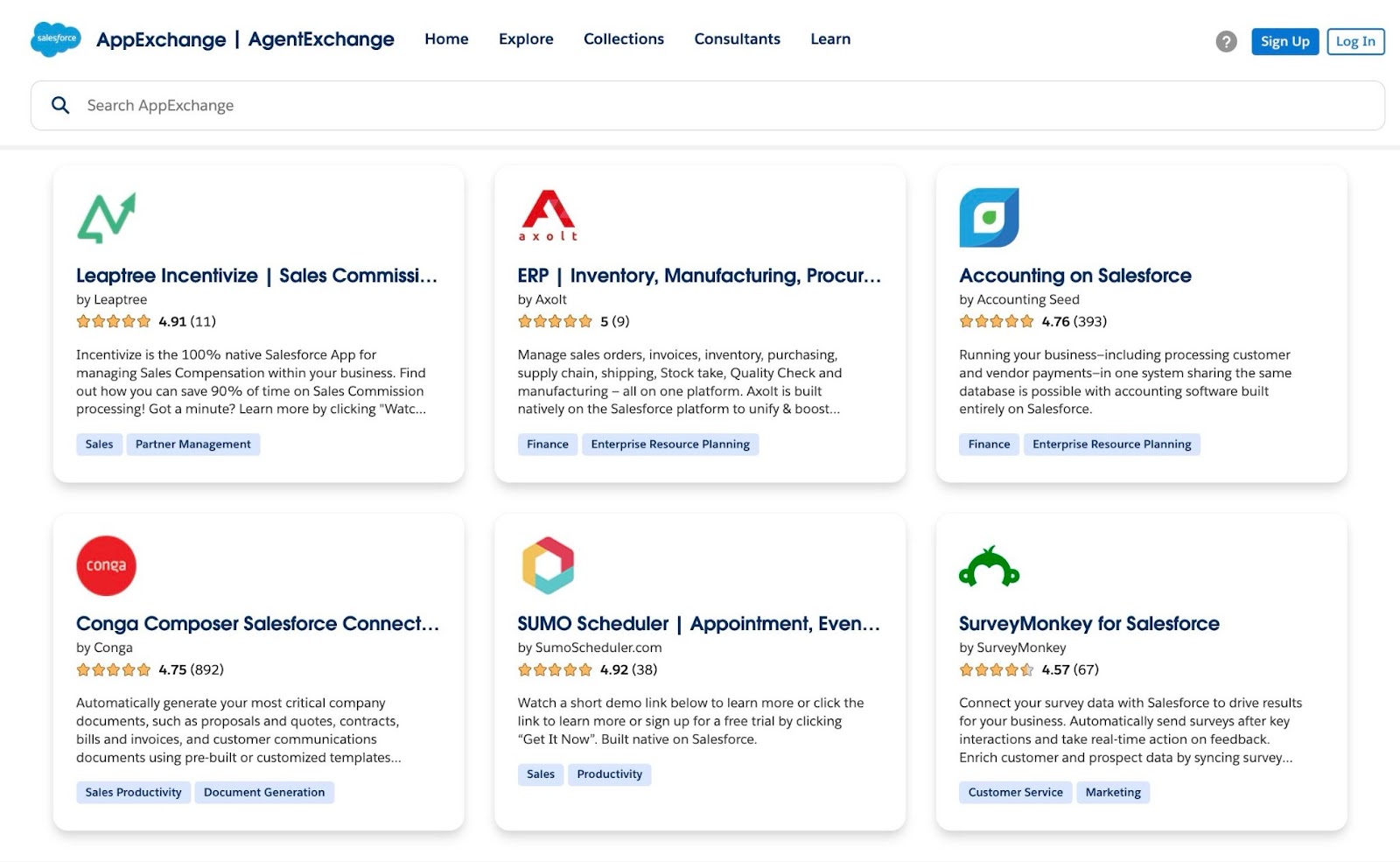
Salesforce has a network of thousands of consulting firms and systems integrators who customize and implement Salesforce for specific industries. They've also built an entire ecosystem around value-added referrals through their AppExchange marketplace, which allows partners to list their Salesforce-friendly products in exchange for a small cut (similar to, say, the App Store).
CS-triggered referrals are timed around key success moments. The idea is simple: ask for a referral when the customer is happiest. That could be right after onboarding, a major win, a milestone reached, or a glowing NPS score. It’s proactive, contextual, and feels natural because it’s tied to real value delivered.
They work best when:
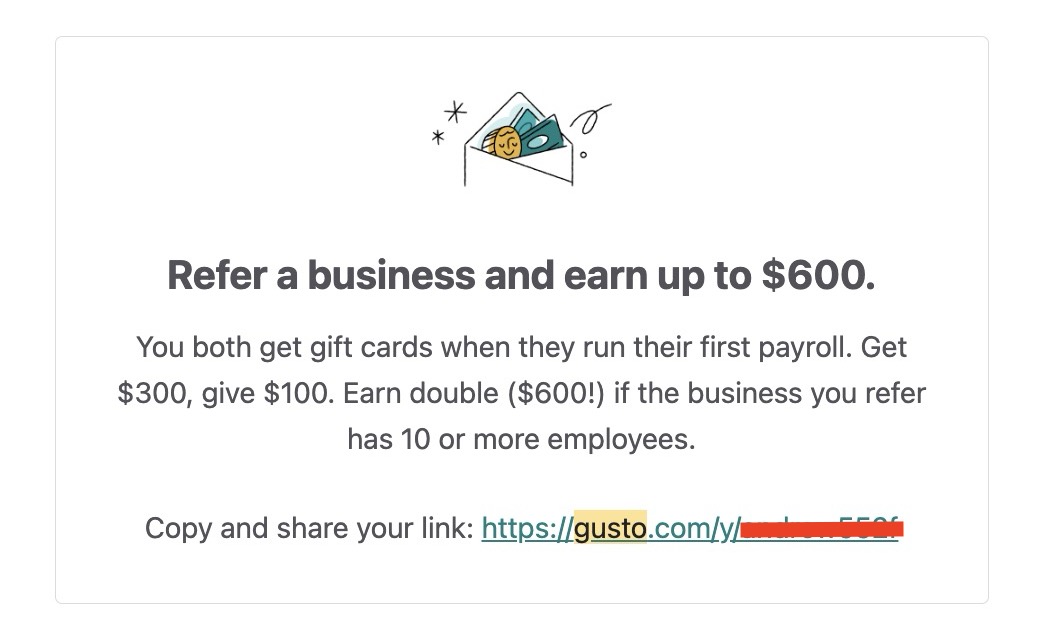
Gusto, the payroll and HR platform, triggers referral asks via email at specific customer milestones, like when someone runs their first successful payroll. These moments are high-trust and high-satisfaction, making the ask feel timely. Gusto offers $300 for each successful referral, but what makes it work is the when, not just the what.
The best B2B referral programs don’t just ask for referrals, they make people want to send them. And while cash is nice, it’s not always the most motivating incentive. What works better is rewards that feel aligned with your brand, your product, and your referrer’s goals.
When designing your referral incentive, you’ll need to decide: do you reward just the referrer, or both the referrer and the referee?

One-sided incentives reward only the person making the referral. They’re flexible, easy to implement and track, and work well in affiliate-style or performance-based programs. But, they can feel transactional.
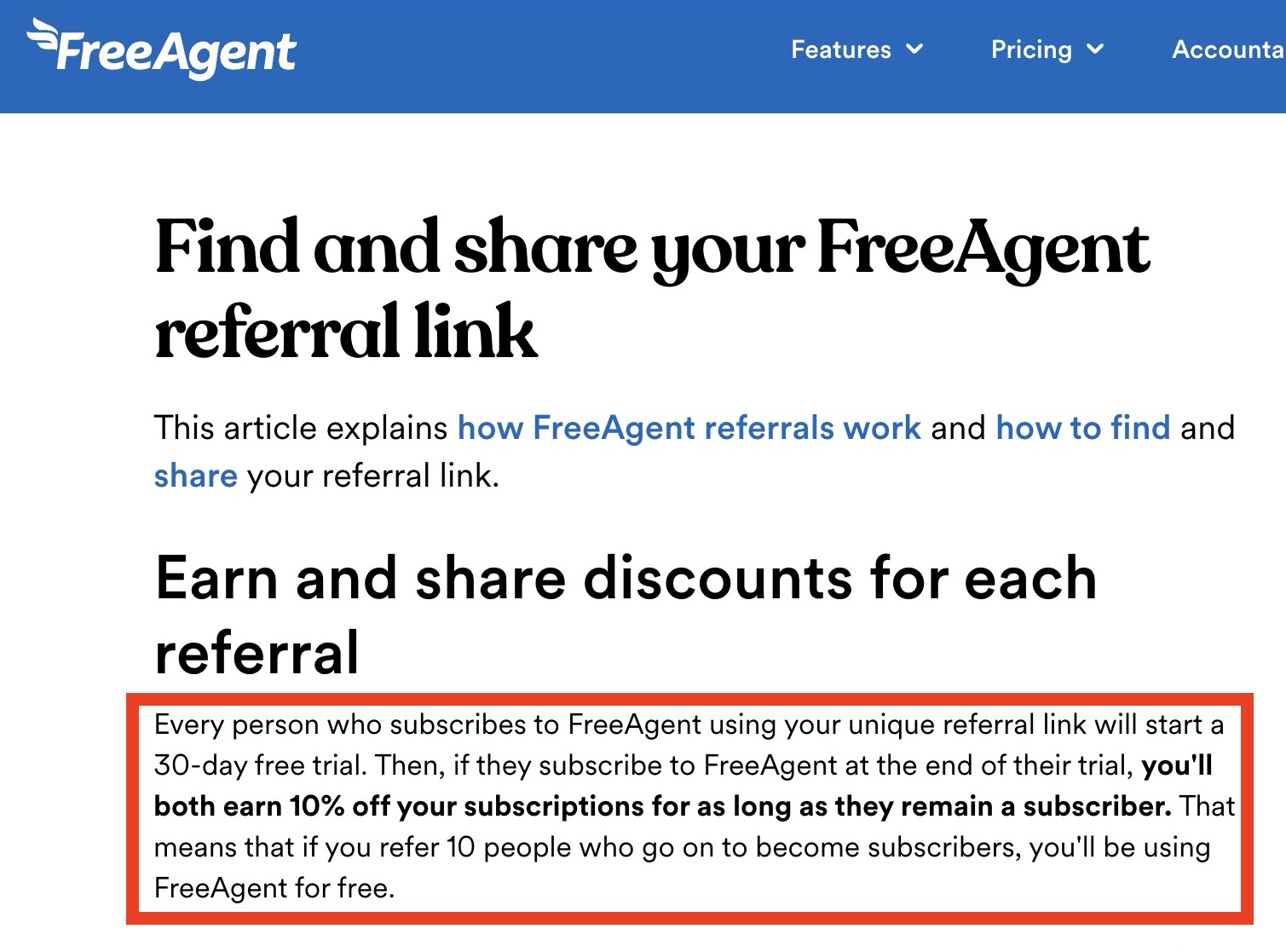
Dual-sided incentives reward the referrer and the person being referred. The incentive for the referee might be a discount, onboarding perk, or exclusive access — something that makes accepting the intro feel like a win. They encourage referrals within close professional networks, but they're slightly harder to manage.
The bottom line: If you're focused on volume and reach, one-sided incentives can scale faster. But if you're focused on quality and relationship-based referrals, dual-sided incentives build more trust—and often result in higher conversion rates.
Just like with pricing, your referral incentives can be variable or fixed. The structure you choose signals how much you value a referral and determines how scalable (or risky) the program is as it grows.
The former scales with deal size, making it ultra-appealing for high-ticket B2B sales. It's the best way to reward partners, consultants, or affiliates who influence large deals. But it's too “salesy” in peer-to-peer or customer referral contexts.
Instead of a flat payout, our users see better results when they offer bigger rewards for higher-impact referrals.
This aligns your incentive spend with real business results and motivates referrers to send quality, not just quantity.
Pro tip: Add surprise bonuses for hitting milestones — e.g., “Refer 3 companies this quarter, and get a free ticket to our annual summit.”
Your goal here is simple: make it ridiculously easy for people to refer you, and equally easy for your team to track and reward them.
Here’s how to build a referral process that scales:
You need a system that tracks referrals from start to finish: who sent them, where they came from, what stage they’re in, and how much they’re worth. Deeto offers end-to-end referral management built for B2B. It automates everything from referral tracking to CRM sync and reward fulfillment.
You can use it to:
Pro tip: Deeto even lets you run multiple referral workflows simultaneously—ideal if you want to test user referrals and partner referrals side-by-side.
Referrals work best when they’re timely. With Deeto, you can trigger referral asks automatically based on customer behavior, like completing onboarding, hitting a usage milestone, or giving a high NPS score.
Examples:
Deeto lets you plug these touchpoints right into your product or email flows without manual setup.
If users and your internal teams can’t track what's happening, you won't be able to scale your program past a few people.
Deeto provides a clean, branded referral dashboard where:
This transparency builds momentum and reduces support tickets.
No matter how much you can do with software, you still need a person responsible for referral performance (either from sales or CS). That owner should monitor the pipeline, update campaigns, and coordinate with sales and CS.
Within your platform, make sure you track referral velocity and conversion and run reports for department leaders.
If you're stuck approving every single reward that goes out, you won't be able to handle the simple handoffs like a user sharing their link with a coworker.
Deeto automates payouts using the link for attribution, whether it’s:
You define the trigger — lead qualified, meeting booked, deal closed — and Deeto handles the rest.
Referrals touch every team, so make it easy for Sales and CS to participate. Reps from both departments should be able to submit referrals from directly inside their workflow, then get notified when a customer becomes eligible to refer.
They should also be able to view each referral's impact on closed-won revenue, and each referrer's net impact on revenue growth overall.
That way, you're actually operationalizing your referrals across the whole company.
To prove ROI (and optimize for it over time), you need clear metrics and tight feedback loops. For that, there are six critical metrics to measure:
As your referral rate increases, you should see corresponding decreases in time-to-close and CAC and corresponding increases in conversions and CLV.
Most B2B referral programs don’t fail because the idea was bad. They fail because the execution overlooked the nuances of how people behave, how B2B sales actually work, or how to keep momentum alive.
Here's why that happens, and what to do instead:
Too many companies launch a referral program, mention it once in a newsletter, build a web page for it, and then wait for leads to roll in.
What to do instead: Treat your referral program like a product launch. Create email campaigns, in-app prompts, customer success scripts, and partner webinars that actively promote it.
If your reward system takes a math degree to understand or offers something your audience doesn’t value, you'll struggle to find advocates willing to take part, and you'll have a hard time scaling your program.
What to do instead: Test rewards with your audience before rolling them out. Use surveys or interviews to find out what they actually care about (hint: it’s not always cash). Then simplify the terms and spell them out in plain English.
Most businesses ask for referrals at the wrong time—either too early (before value is proven) or too late (when engagement has faded).
What to do instead:
Map your customer journey and pinpoint moments of peak satisfaction—right after onboarding success, a positive CSAT score, or a product milestone. That’s when to ask for a referral.
A silent program is a dead program. If referrers never hear back about their leads or rewards, they might stop referring, even if they love your product.
What to do instead: Automate acknowledgment emails, status updates, and payout confirmations. Over-communicate, not under.
You'd be surprised how many programs stall because no one internally knows what’s working, what’s not, or how to improve it (you can solve this with software).
What to do instead: Build analytics into your program from day one. Use UTM links, CRM tracking, or referral software to measure source quality, win rates, and payout effectiveness. Review monthly and iterate quickly.
What works for self-serve SaaS products won’t work for enterprise-tier products. More complicated sales cycles require additional tiers, terms, and tracking mechanisms.
What to do instead: Tailor your referral motion to your sales cycle, deal size, and buyer behavior. Enterprise deals need referral introductions, not just link shares and signups. Your program should reflect that nuance.
Deeto gives you a centralized hub to run, measure, and optimize referral programs that scale. Instead of duct-taping spreadsheets to email sequences, you get a system that just works (and grows with you).
With Deeto, you can:
And it centralizes dozens of other customer-led growth tools: testimonial capture, case study workflows, UGC collection and curation, reference management, and more.
Request a demo to see it in action.

Discover how to build a powerful B2B referral program with proven strategies, referral ideas, and tools to drive leads.
Social proof is the concept that people are more likely to trust and follow the actions of others, especially when it comes to decision making. And it's your most valuable marketing asset — adding a few reviews to your site can double your sales and increase your conversion rate by up to 270%.
These 3 companies have got the whole “social proof” thing down.
Faddom does everything right. From the logo displays in the hero section to the embedded customer reviews, everything is done with purpose and style.
Placing logos of your clients/customers on a carousel is one of the fastest ways to validate your product or service. It's also one of the easiest changes you can make, and it can increase web sales by 400%.
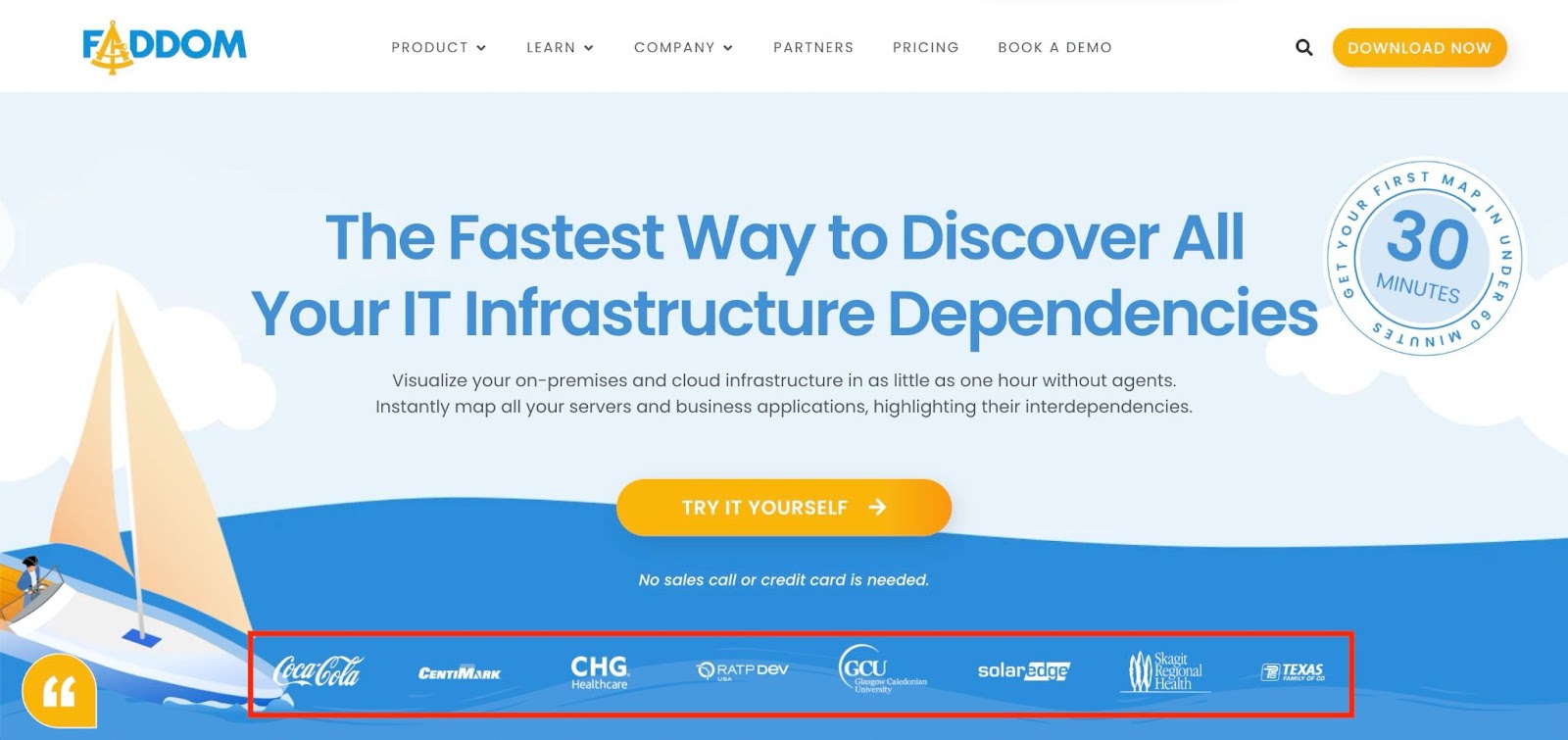
They also do a phenomenal job of highlighting reviews from third-party sites like G2 and Capterra — something you can set up with a simple website integration.
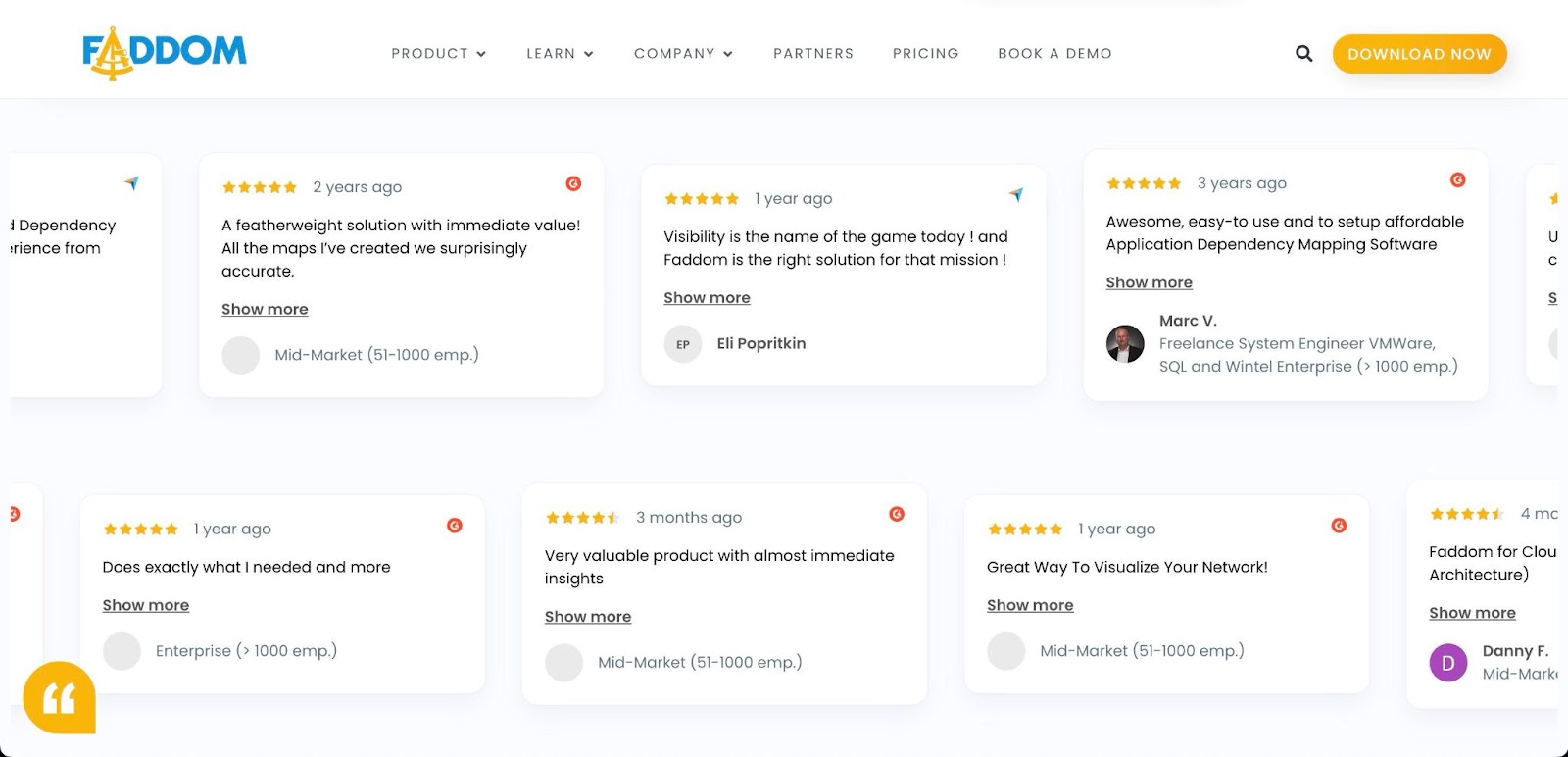
But Faddom takes it a step further. The IT migration software vendor integrates customer quotes directly into their copy (in multiple different formats).
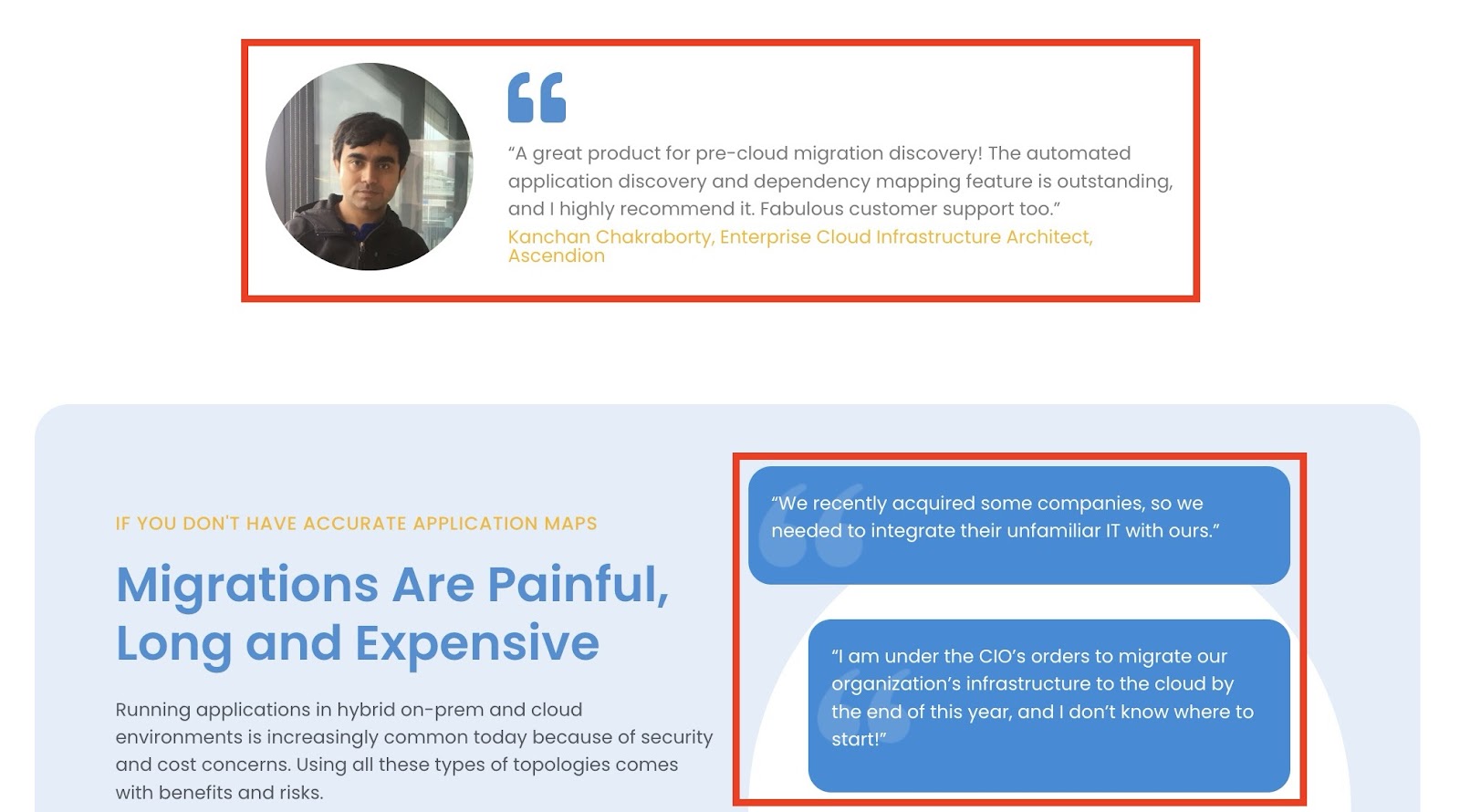
Plenty of companies are already doing these things. Faddom takes their social proof to the next level with Deeto's AI-powered social proof widget, which they use to dynamically display customers' testimonials across every page of their site.
When someone lands on a new page, they're met with a popup widget that showcases a relevant customer review.
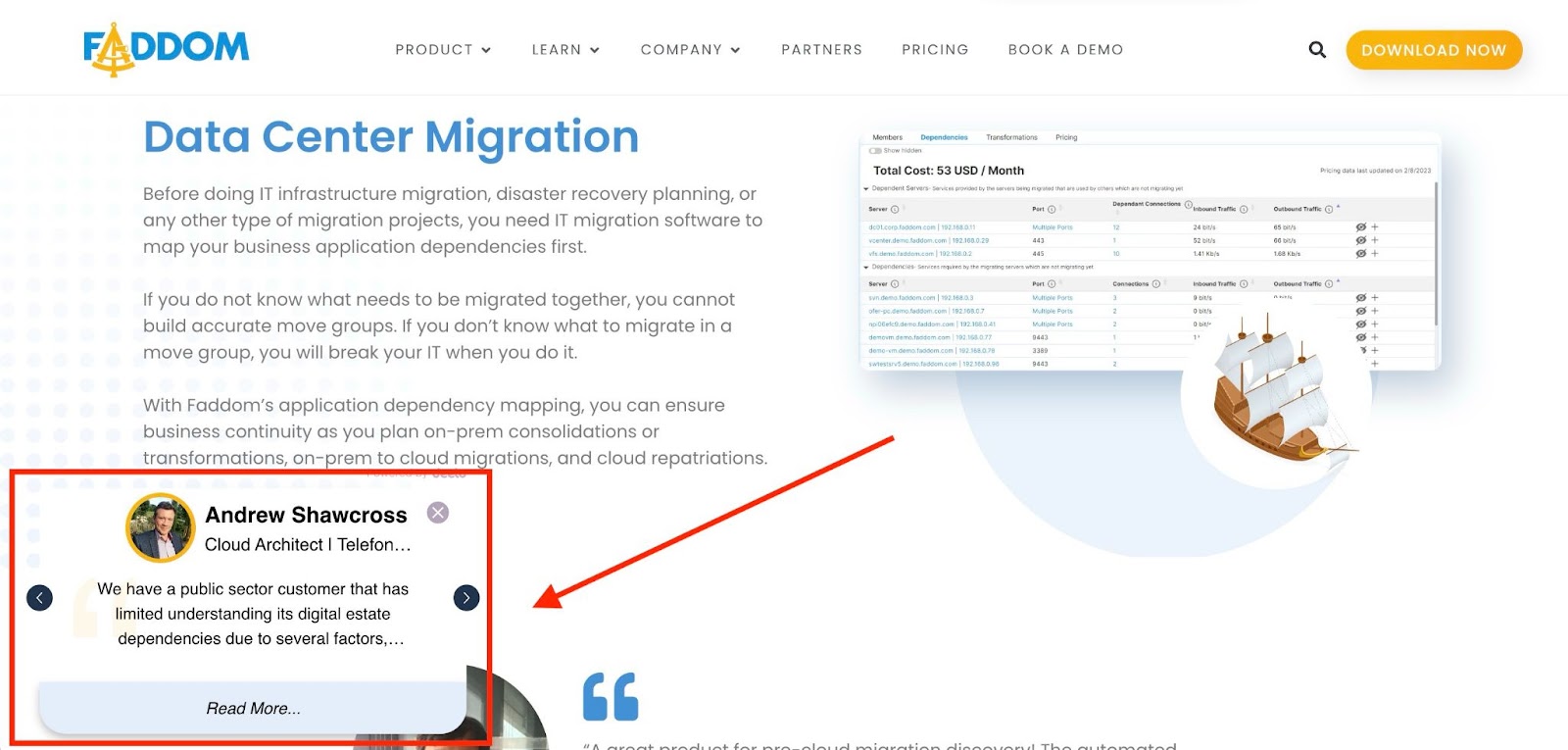
They can click on the review to read the whole thing.
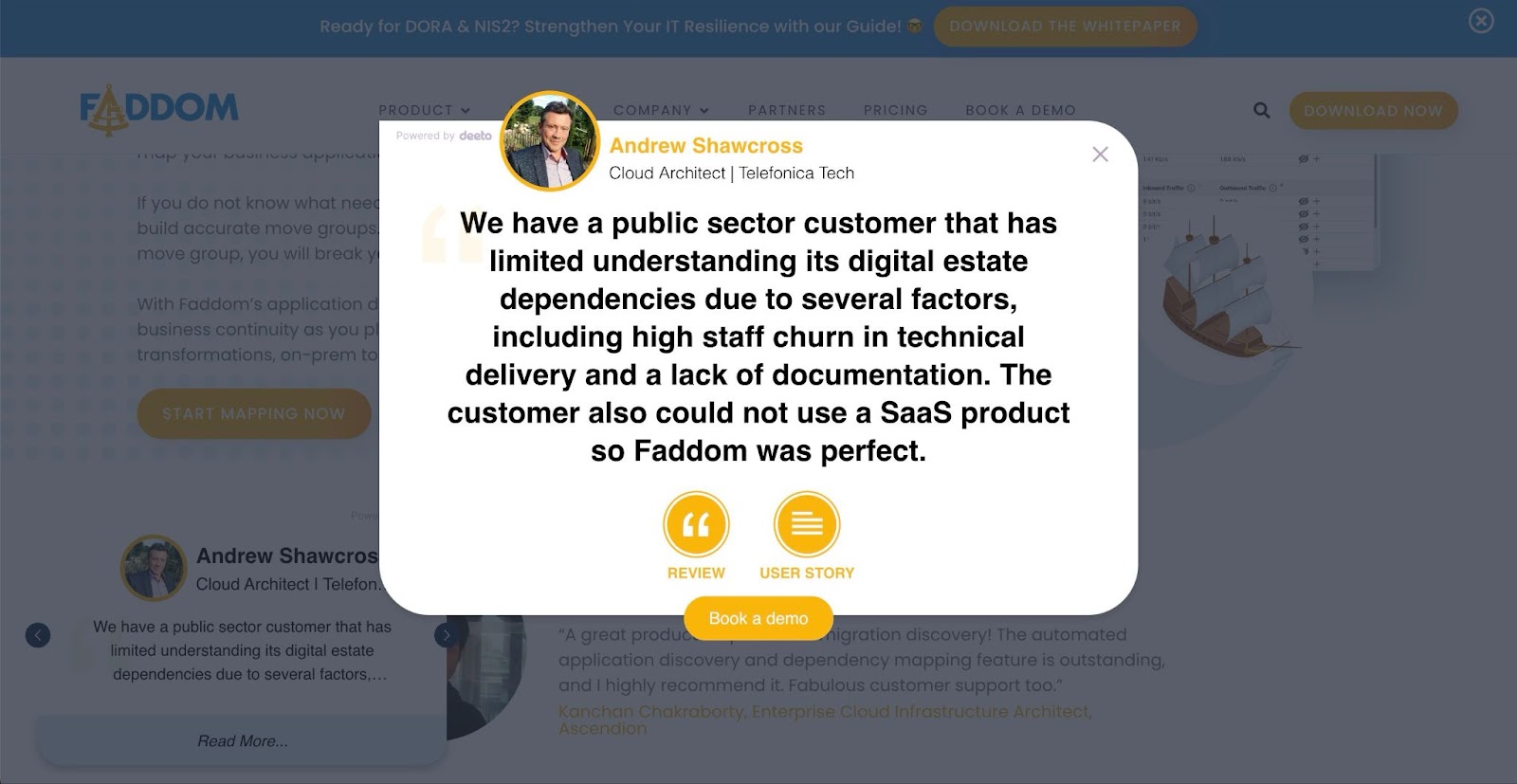
The site visitor can even check out the user story — a quick, digestible case study on how Faddom made such a positive impact on their business.
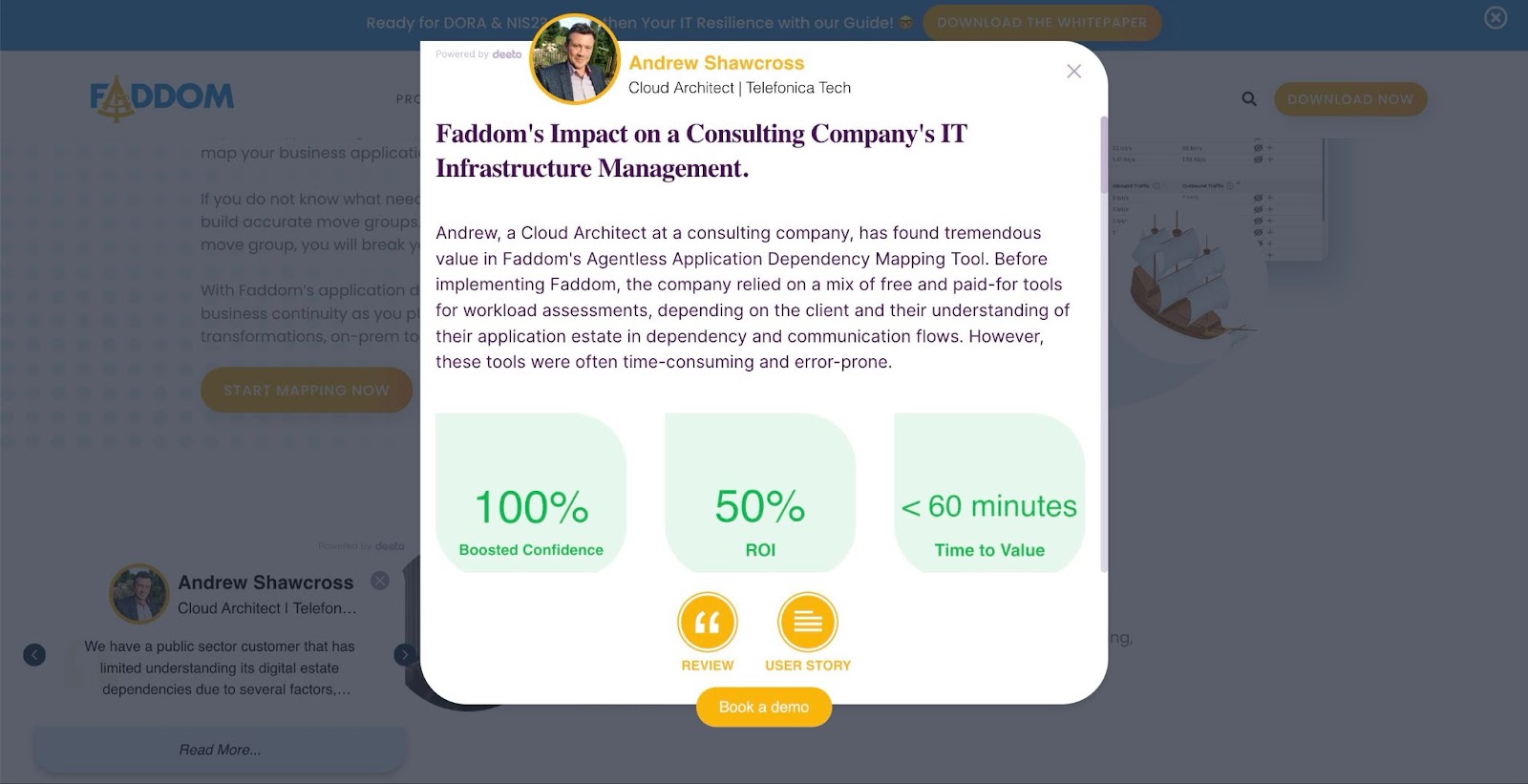
The best part about this is, Faddom didn’t have to spend any time collecting the feedback or building the case study. Deeto's generative AI created it for them in seconds using results, statistics, and feedback their customer submitted through the system.
The most scalable, hands-off way to do social proof. A+, Faddom.
Ashby is an ATS (applicant tracking system) software that helps companies streamline their hiring process.
What we love most about their approach to social proof is how their customers' testimonials go beyond "this product is great" or "we're so happy we made the switch". They highlight specific features and benefits in their reviews.
For example:
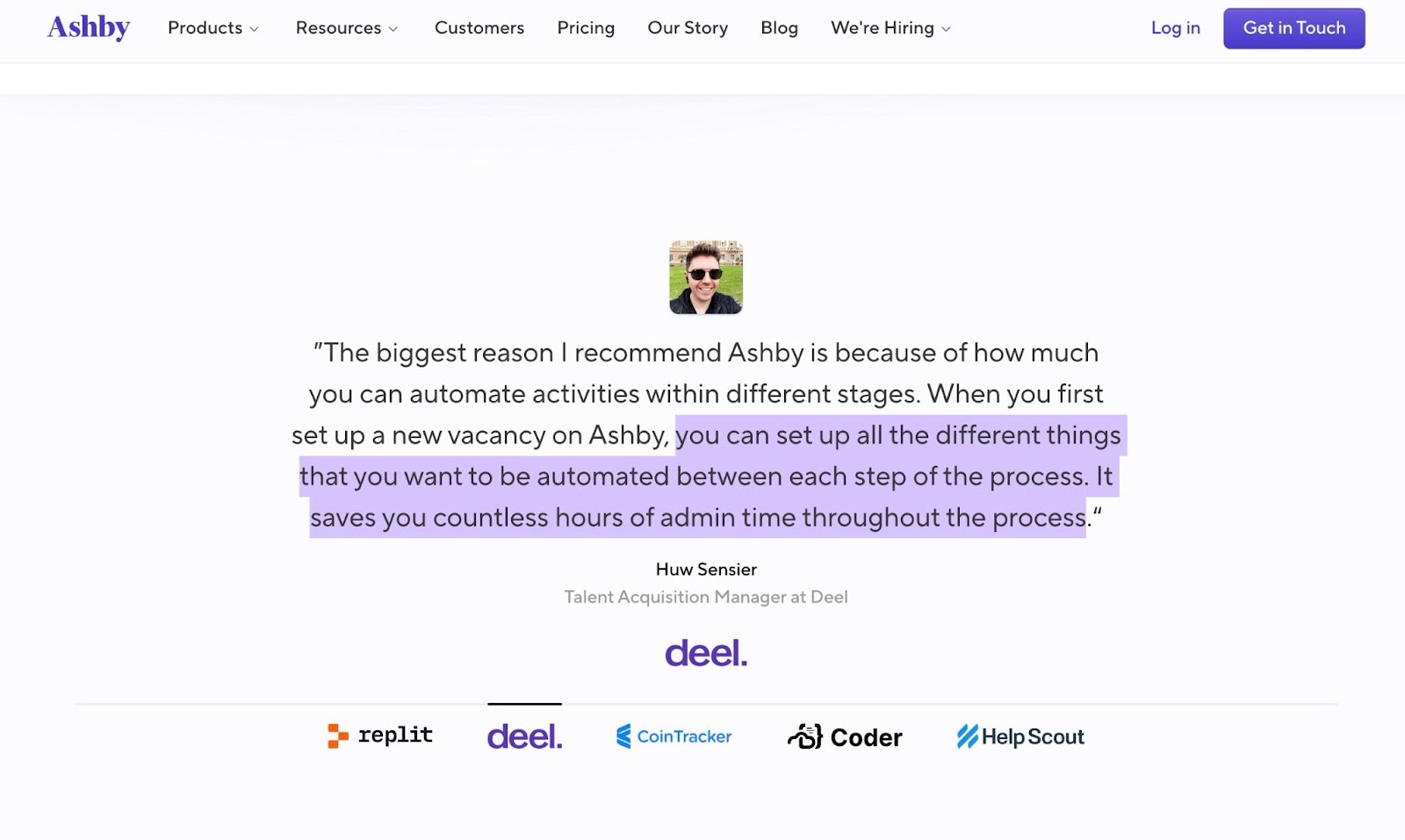
When a customer reads this, they understand features in a real-world context, which is far more relevant.
Getting these types of responses from your customers is simple. When getting feedback from your customers, ask them questions that warrant these responses.
For example:
Ashby also uses customers' voices to reinforce the points they're making in their blog articles.
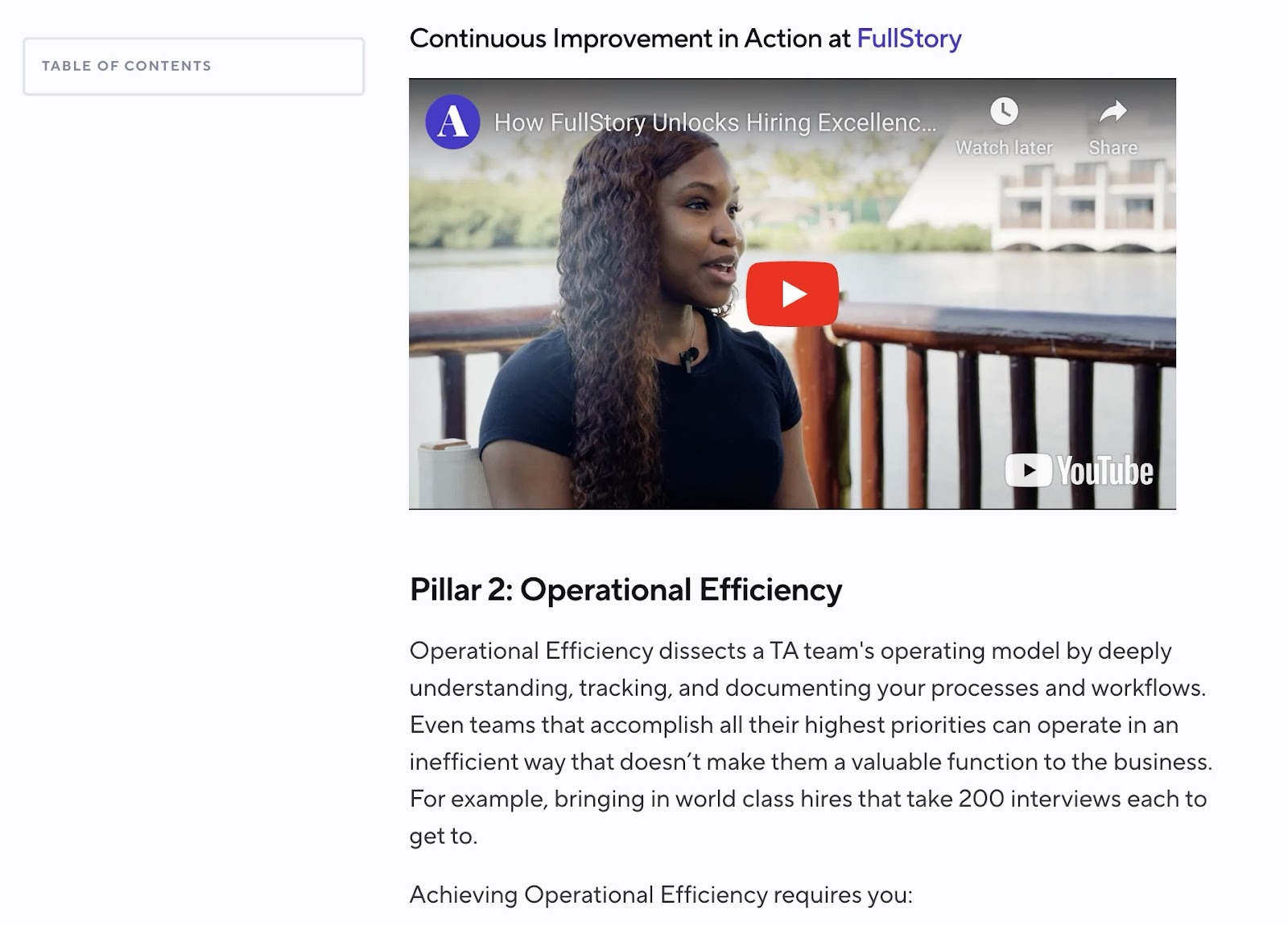
Their argument here is that the first of three pillars of hiring excellence is "continuous improvement." So, they pulled a customer who uses Asby to exemplify that pillar and featured them in that article section.
Warmly is an AI tool that aggregates hundreds of buying signals to identify warm leads. They simplify contextualized sales outreach.
On their product pages, the hero section includes a customer testimonial and an option to watch its corresponding video. Customers see proof as soon as they land on the page.
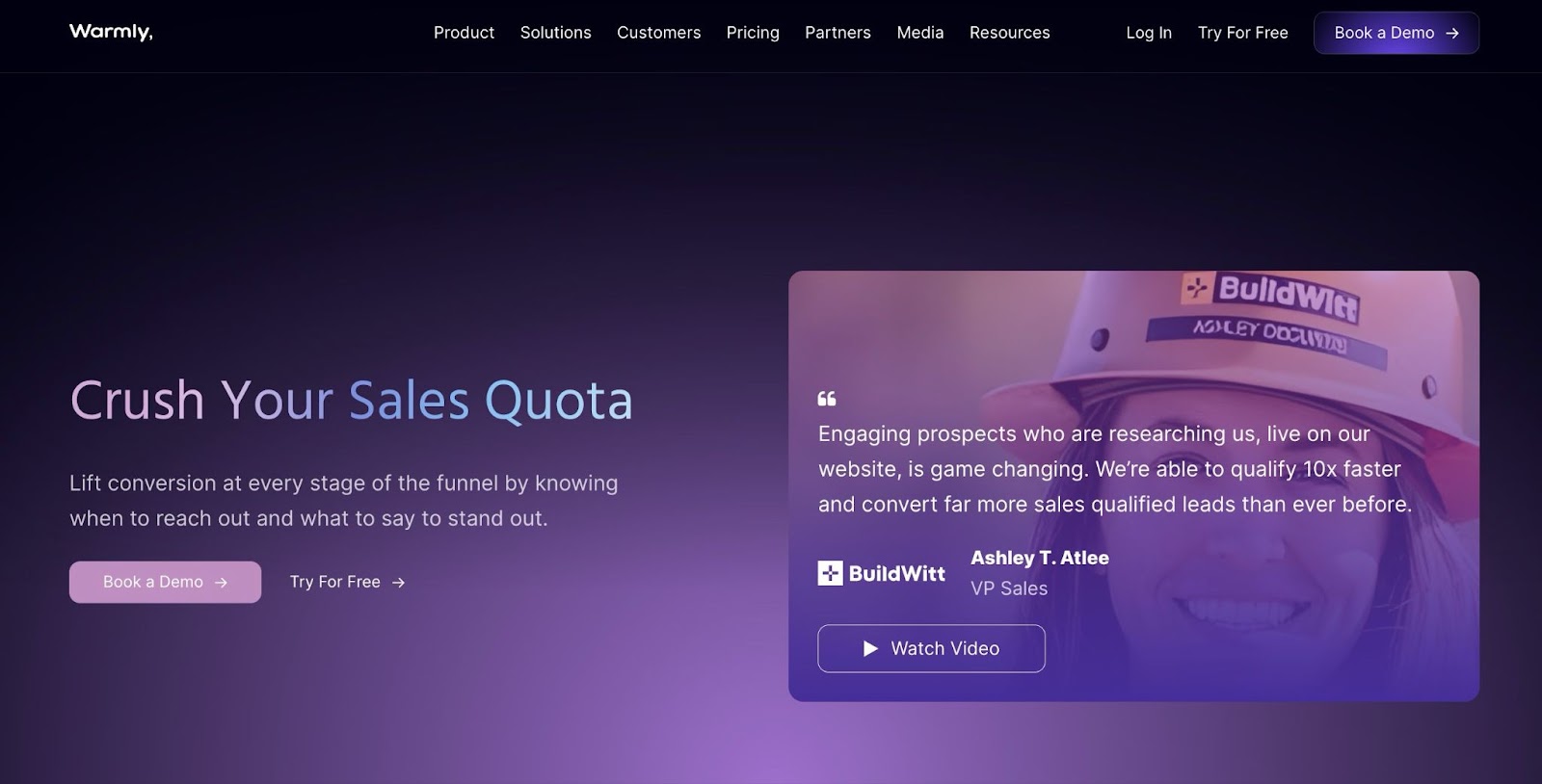
They've also embedded positive reviews from third-party review sites, social media platforms, and internal feedback via Slack directly into their website on what they call their "Wall of Love." Each link takes the reader to the respective post, so everything is 100% verifiable.
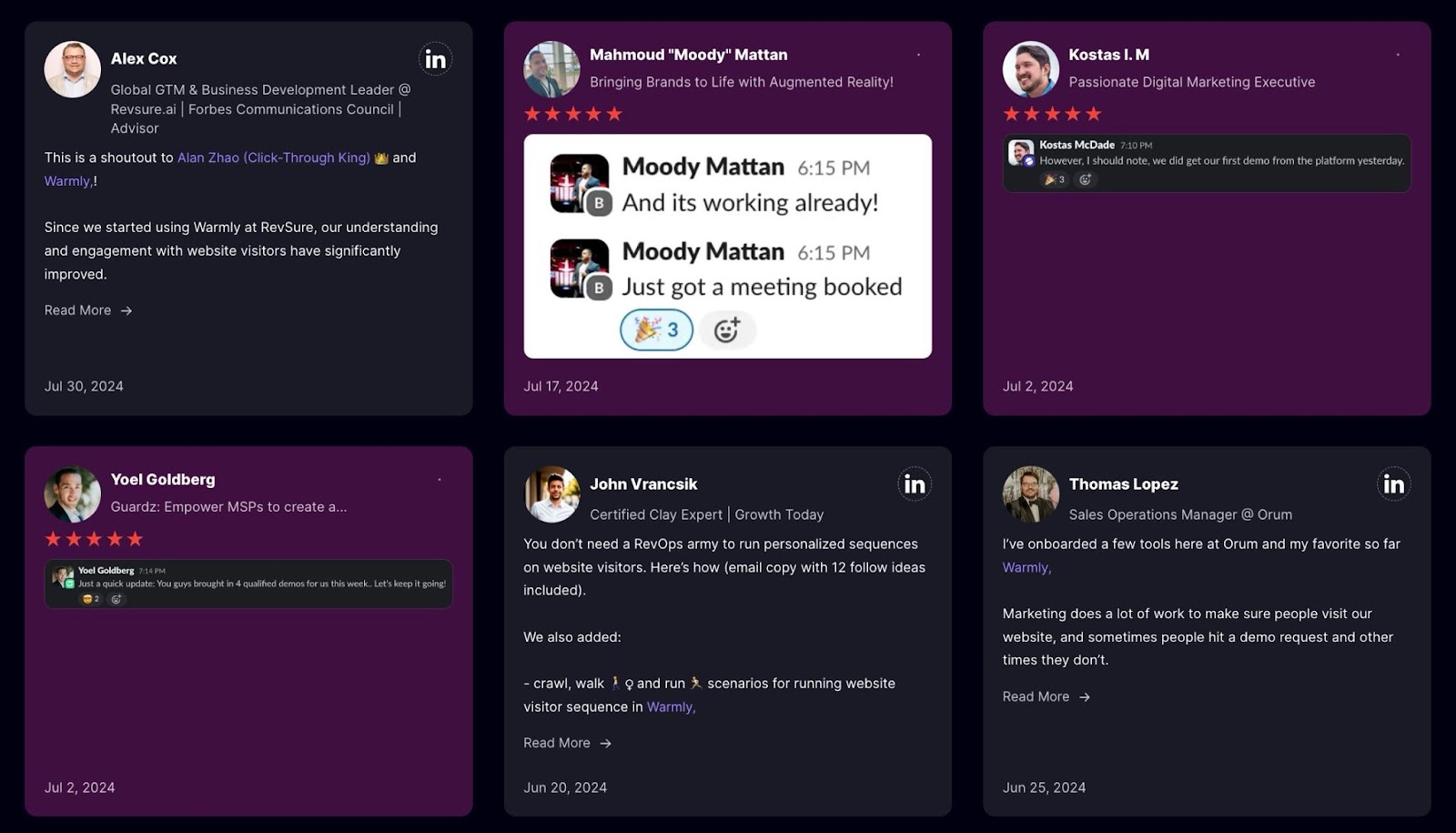
What's also great about their website is it highlights tangible results (like "282% ROI in 6 months"), linked to full-fledged case studies.
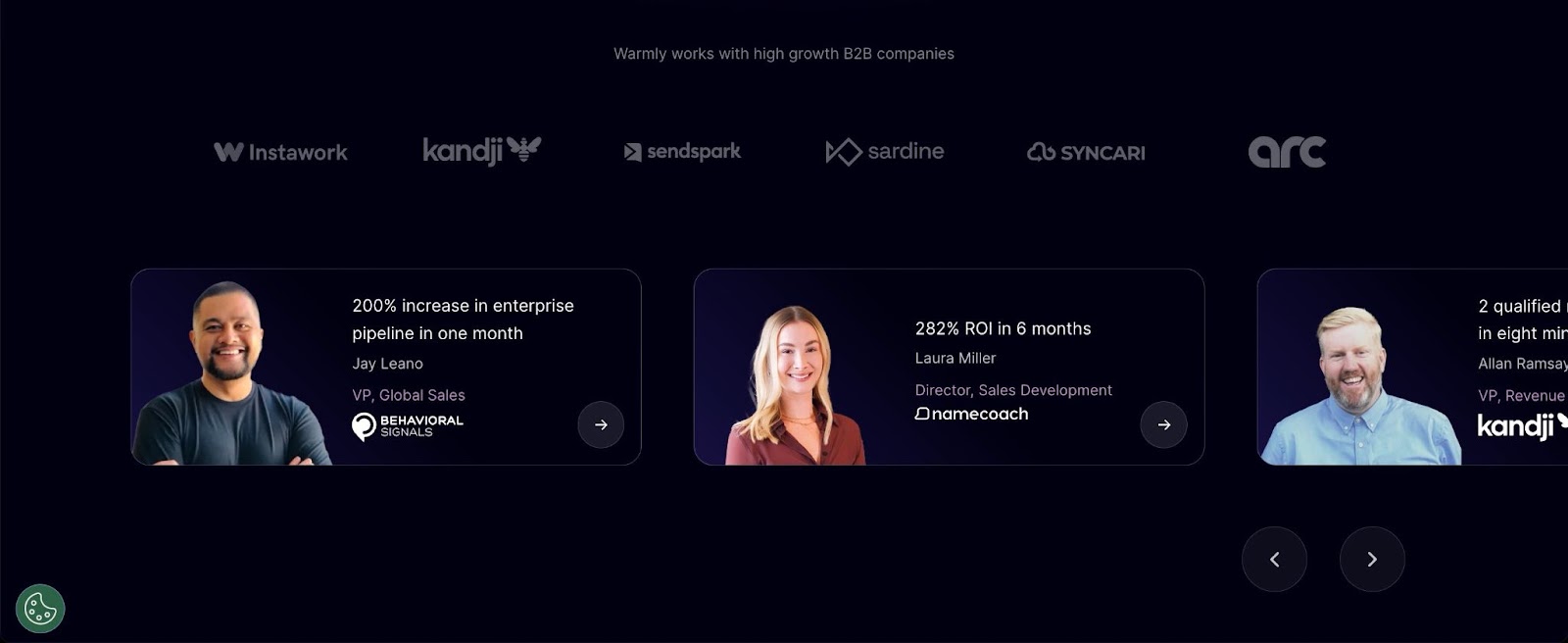
Oh, yeah. And they've got dozens of excellent case studies.
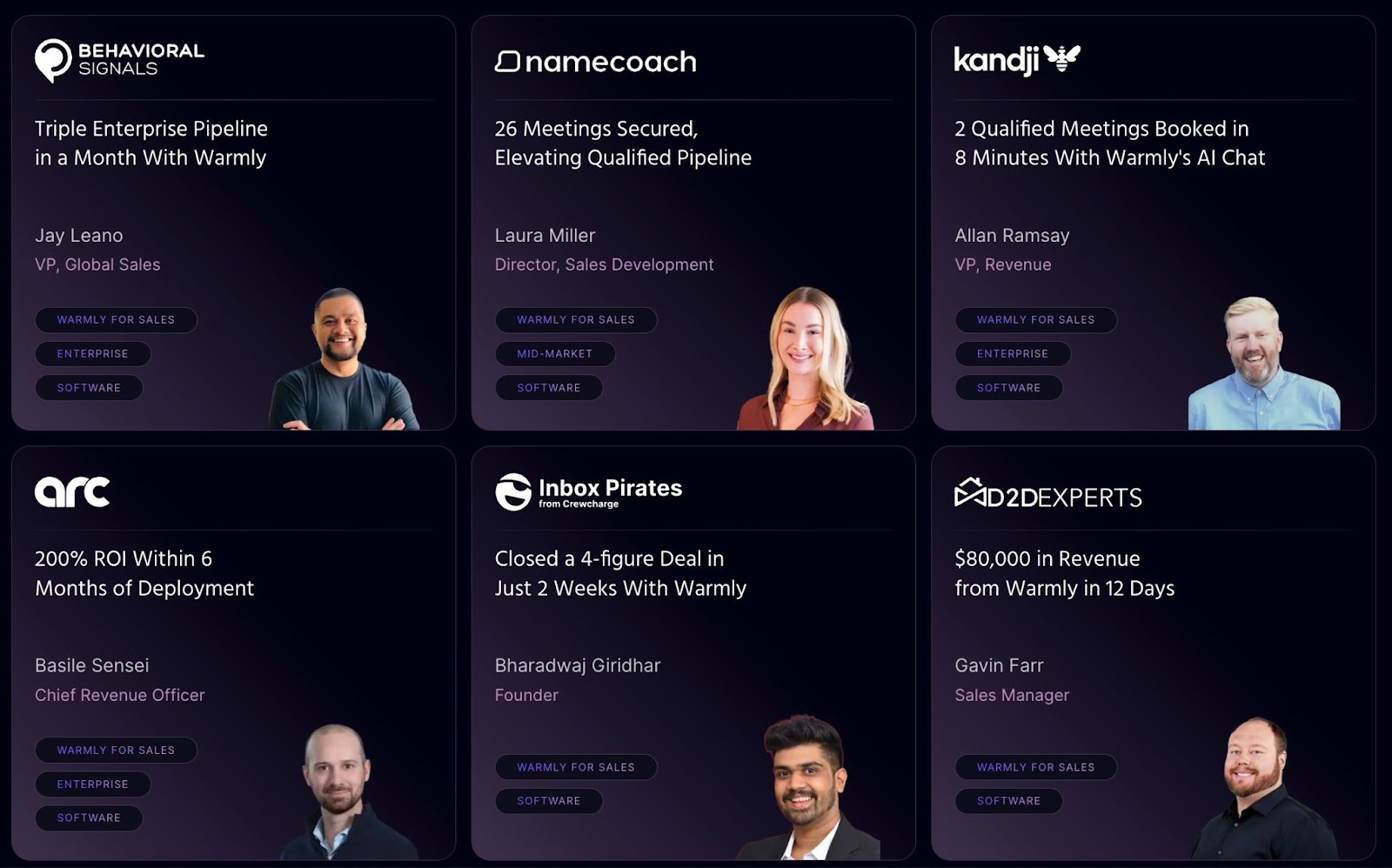
They also feature customer testimonials prominently throughout their site. And just like Ashby, they're passionate, well-written, and chock-full of use-case-oriented language.
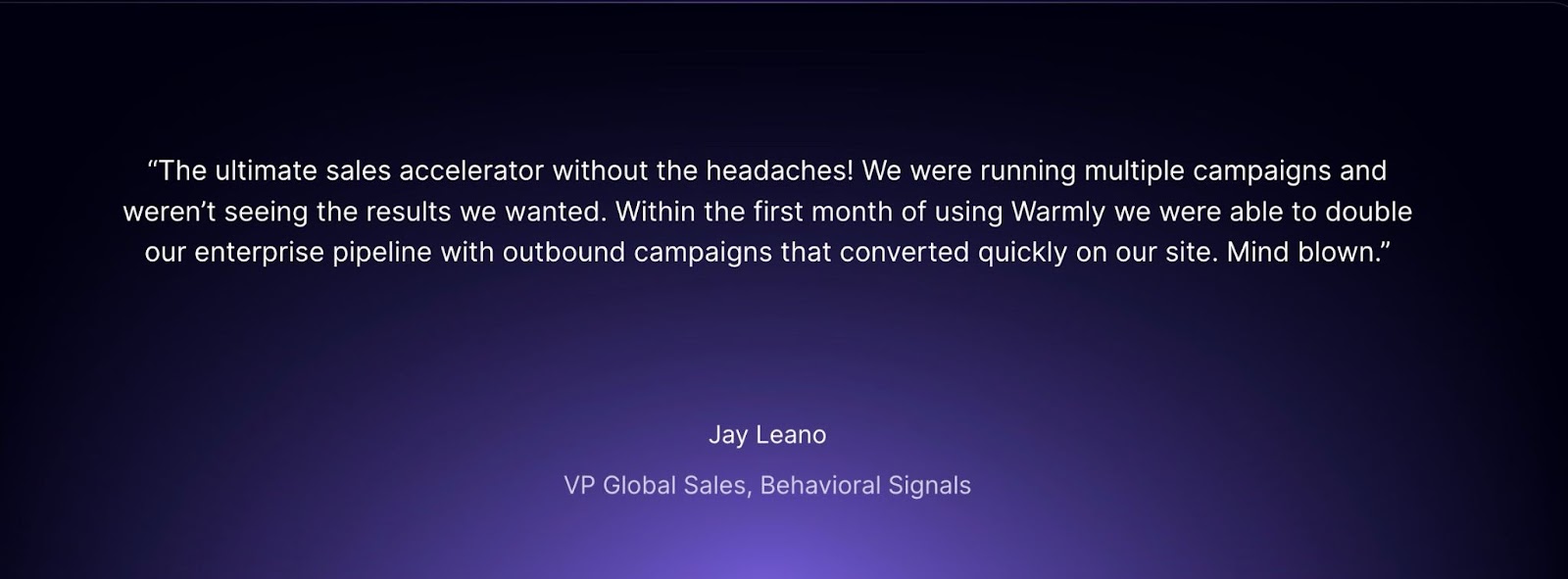
Deeto makes it easy to collect, curate, and distribute social proof across your website. Request a demo to see how it works.

See how 3 brands use social proof software to boost web conversions and learn how to use social proof effectively.
If you're still basing campaigns on gut instinct and internal brainstorming sessions, you're completely missing what marketing's about. Modern marketing doesn’t start with your product. It starts with your customer.
Customer-led marketing flips the traditional playbook. It replaces "trust me, our product is great" with irrefutable proof that it is.
In this article, I'll break down what customer-led marketing is, why it works, and how B2B brands can use it to drive real growth.
First, a quick definition:
Customer-led marketing is a strategy that puts your customers at the center of your growth engine — not just as buyers, but as advocates. It amplifies their voice, stories, and influence across your marketing through referrals, reviews, case studies, and user-generated content.
Successful marketing is all about relevance. A customer-led approach delivers it right from the source.
Buyers today are overwhelmed with noise and short on patience. They tune out anything that doesn’t speak directly to their needs. Customer-led marketing cuts through the noise by anchoring your strategy in what your audience actually cares about.
Most importantly, it's a core aspect of your broader customer-led growth (CLG) strategy. Feedback from your customers also allows you to constantly improve and iterate on your offering, and your sales team can use it to seal the deal with potential customers.
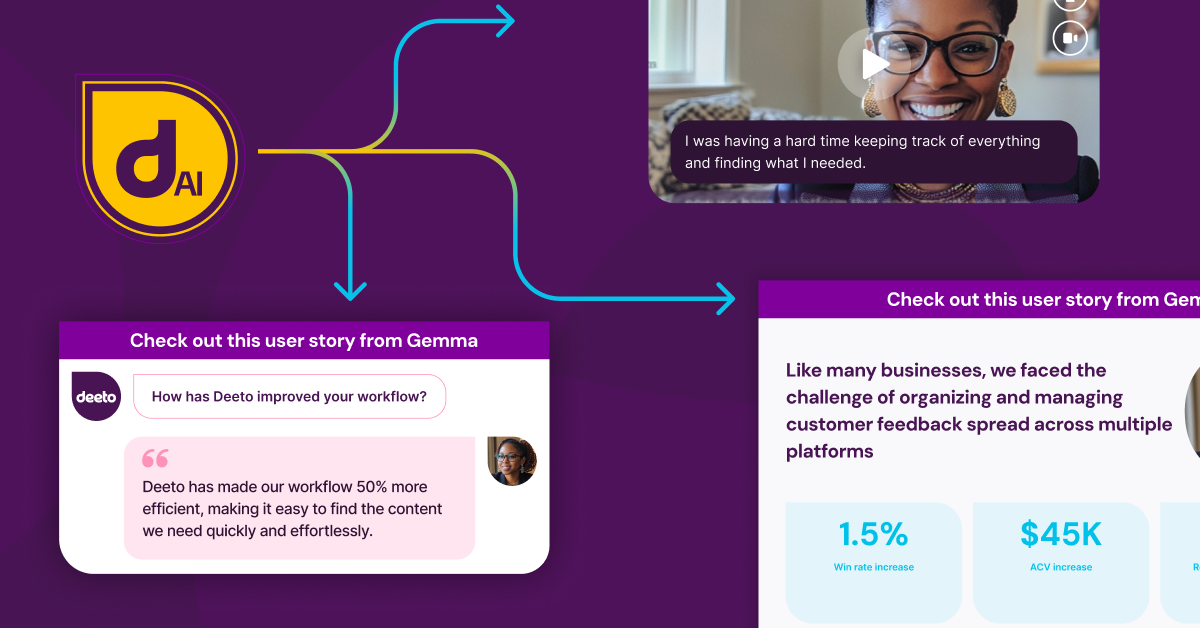
In customer-led marketing, the Voice of the Customer is the message. Instead of just talking about your value, you let your customers do it for you through testimonials, reviews, social posts, community engagement, and word-of-mouth.
The best B2B brands build systems to:
When your buyers hear from someone who looks like them, faces the same challenges, and has already found success with your product, it hits differently. It’s more believable. More persuasive. More scalable.
To activate customer advocacy at scale, you need to know who your best customers are, what makes them successful, and how they’re already spreading the word.
That means going beyond surface-level analytics. You’re digging into:
Once you know who’s already leaving reviews, sending you new leads, and talking about you on socials, you can double down on what’s working and create systems to repeat it.
Different customers engage in different ways. Some love being featured in case studies, others prefer a short quote or a behind-the-scenes referral. As you build your customer advocacy program, it needs to flex based on their preferences, communication styles, and comfort levels.
That’s the first layer of personalization: how you invite customers to participate.
The second is how you deploy their stories.
Not all social proof is equally effective for every audience. Insights from an enterprise IT director won’t resonate with a solo founder of a creative agency, even if both love your product.
To make customer marketing work:
The more relevant the voice, the more persuasive the message.
When prospects see real customers sharing results, naming specific challenges, or publicly vouching for your team, it builds instant credibility.
But again, not all proof is created equal. To maximize trust, your advocacy assets should:
Customers who advocate for you also become more invested in your success. They’re less likely to churn, more likely to refer others, and more open to feedback loops.
That’s where the full potential of customer-led growth kicks in. You’re not just using your customers to sell, you’re growing with them. You're improving your product and experience based on their input.
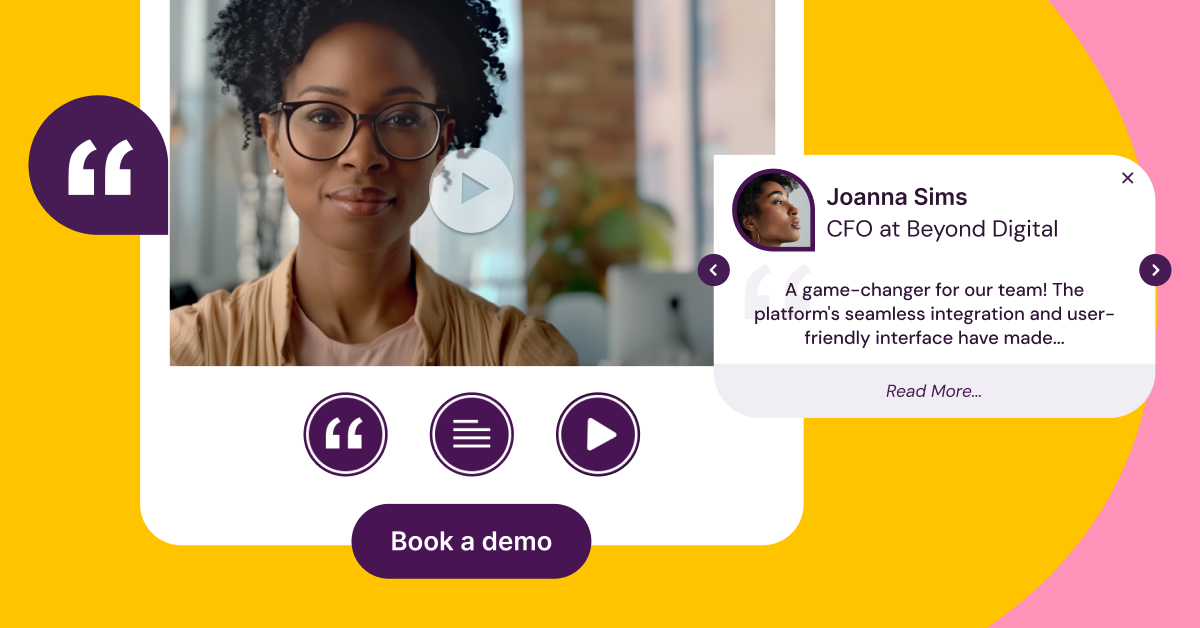
When you turn customers into advocates, you unlock compounding returns across your entire go-to-market engine. Not to mention, putting them at the center of your marketing is a lot easier than guessing what messaging and tactics will drive conversions.
Here’s what that looks like:
A recently published study in the Journal of Brand Management proved something we've all known for years: that customer advocacy significantly enhances brand loyalty.
When you invite your users to share their story, give feedback, or participate in your growth, they build a deeper emotional connection with your brand. That translates into longer lifespans and higher CLV.
By spotlighting real users in your content, campaigns, and community, you create opportunities for organic engagement. Happy customers become marketers themselves, amplifying your reach and credibility in ways no paid ad can replicate.
With Deeto, it's even easier for them to share their experiences. It's both business- and customer-facing, so your customers self-onboard, set their contribution preferences, and leave feedback in a guided user flow.
Customer-led marketing naturally feeds into better product decisions. The same customers who advocate also surface the most valuable opportunities for improvement. Their feedback helps you prioritize features, enhance onboarding, and close experience gaps.
People trust people, not brands.
In Forrester’s 2023 B2B Brand and Communications Survey, over 90% of B2B buyers said they "completely" or "somewhat" trust peers in their industry, and 85% trust customers of vendors in their industry. By contrast, only 29% trust claims from the vendors themselves.
So when your messaging comes from customers, it converts better. You waste less time creating content that doesn’t resonate and more time doubling down on what actually drives pipeline. Every quote, case study, and referral becomes an asset that pays off again and again.
Maybe it goes without saying, but customer-led marketing isn't something you can just bolt on. Here’s how to turn the philosophy into an actual strategy:
Gather feedback across every touchpoint:
Then, analyze it for themes, patterns, and hidden insights.
Deeto makes this first step a lot easier by helping you capture Voice of the Customer data and auto-translating it into usable insights.
Use your feedback and behavioral data to pinpoint what actually matters to your customers: their goals, pain points, buying triggers, and success milestones. Then group those patterns into personas that reflect the reality of your audience, not a marketer’s imagination.
These personas should guide your messaging, campaigns, and even what kind of advocates you spotlight in certain areas.
The most trustworthy marketing comes from your customers, not your brand. Invite them to share their stories on social, leave reviews, create video testimonials, or post about their experience. Make it easy and rewarding to participate.
This turns each of your advocates into a distribution channel, helping you scale authenticity without adding a dime to your ad spend.
When you have a steady stream of user-generated content, you can (in fact, you should) repurpose it in your own marketing efforts. In addition to strengthening your messaging, doing this creates a positive feedback loop, where customers are more willing to publish their own content in the future because they see you're amplifying their voices.
Want to see an example? Here are three companies that use social proof to drive web conversions.
Use the feedback you collect not just for content, but for product and experience improvements. That could mean adjusting your onboarding, fixing a broken workflow, or rolling out a feature your top users are asking for.
Deeto’s AI-powered analysis helps you automatically spot trends in customer sentiment, so you don't have to sift through hundreds of reviews or feedback forms to find them.
This isn’t just a marketing play. Everyone — from product to sales to support — should be tuned into what customers are saying and how they’re contributing to growth.
When the whole company thinks like your customers, marketing becomes a natural extension of your relationship with them.
Customer-led marketing sounds simple: put your customers at the center. In practice, though? It’s a lot more complex.
Here are some of the biggest challenges we see companies face, and how to overcome them without derailing your strategy:
Sometimes, just a small percentage of customers are willing to share publicly. There are a few common reasons for this, but it's especially true in B2B where approvals, legal constraints, and privacy concerns slow everything down.
The fix: Lower the barrier to entry. Not every advocate needs to be a full case study. Start small — a quote, a social comment, a 15-minute reference call. Build lightweight paths to participation so you're not over-relying on a handful of vocal champions.
Brands frequently overuse a few go-to stories or personas, which can make their content feel repetitive or irrelevant to new buyers. If your customer advocacy strategy doesn't reflect a broader base of customers, you'll alienate potential new buyers who don't see themselves reflected in your current advocates.
The fix: Build a diverse portfolio of advocates. Segment stories by industry, use case, company size, or job title. Map advocacy assets to the full buyer journey. A short-form win for top-of-funnel, a technical deep dive for decision-makers, and a video testimonial for post-sale trust.
Marketing might be all-in on customer-led strategy, but product, sales, and customer success are off doing their own thing. That disconnect limits your ability to gather feedback or use it effectively.
The fix: Operationalize cross-team collaboration. Make customer insights a shared resource. Schedule regular syncs to discuss advocate wins, feedback trends, and messaging that’s working. Create feedback loops where CS and sales actively feed marketing, and see the benefits reflected in their own KPIs.
You gather tons of customer feedback… and then nothing happens. It sits in spreadsheets or survey tools, untouched. Meanwhile, your customers wonder if you’re actually listening.
Customer-led doesn’t mean customer-controlled. But it does mean being responsive and transparent about what you’re doing with their input.
The fix: Use AI-powered tools (like Deeto) to synthesize feedback in real time. Prioritize trends that come from your most successful or high-impact customers. Then — and this is critical — close the loop. Let customers know what you’ve changed based on what they said.
Advocacy isn’t always easy to tie directly to revenue, so it can get deprioritized in favor of more “trackable” tactics like paid ads.
The fix: Start by defining what success looks like. That could be referral volume, influence on pipeline, reduced churn, or shorter sales cycles. Then build advocacy into your attribution models, tracking how often advocates appear in deals, how many customers engage with proof content, or how feedback informs conversion-boosting changes.
You can’t just sit down and make customer-led content the way you would an ad or a blog post. You’re relying on external people — all of whom have their own schedules, priorities, and approval processes — to contribute.
That makes scalability one of the biggest friction points in customer-led marketing. Without the right systems, you end up with a handful of stale assets and a strategy that runs out of steam.
The fix: Use purpose-built customer marketing software to automate what used to be manual.
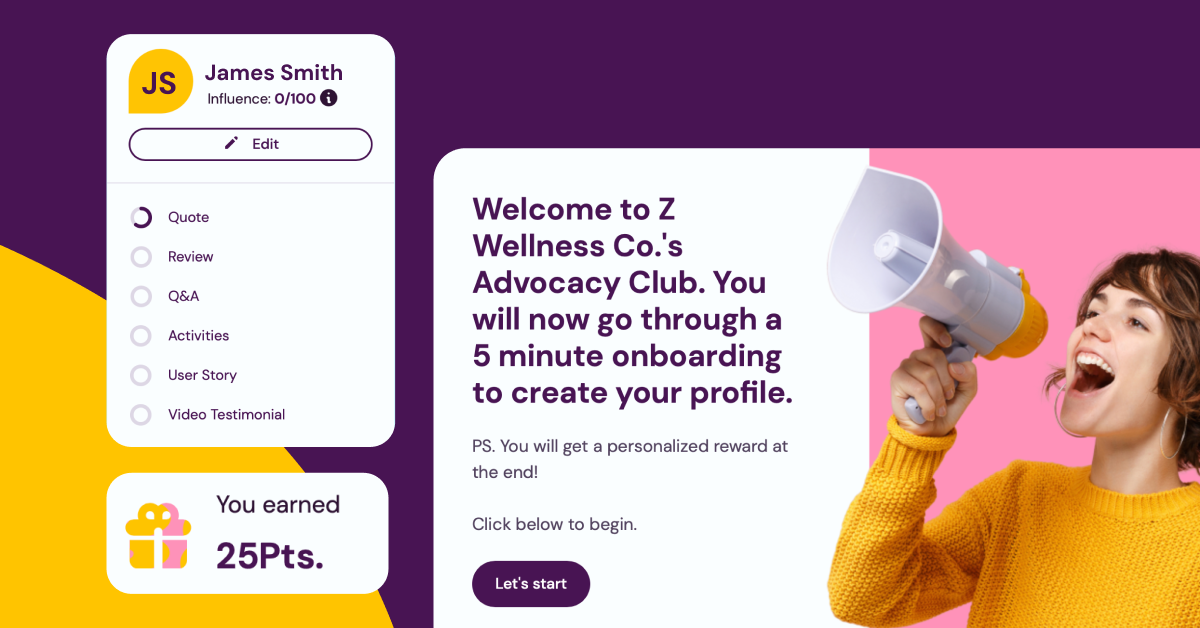
Deeto centralizes your customer-led marketing assets, streamlines content collection through self-service workflows, and scales output using generative AI and smart distribution.
That means:
Essentially, it turns the otherwise haphazard process of gathering and sharing customer insights into a structured, efficient, and measurable strategy that drives repeatable results for your business.
Request a demo to see how it works.

What is customer-led marketing? Learn its definition, benefits, and how to implement a strategy that drives engagement.
Running a startup? Scaling a SaaS business? The tools you use to connect with your audience matter more than ever.
In fact, Salesforce's "State of the Connected Customer" report reveals that 80% of customers now consider the experience a company provides to be as important as its products and services.
Since engaging even a couple dozen customers with a fully manual process is impractical, you'll need to have a customer engagement platform in place.
This article breaks down the 7 best customer engagement platforms in 2025. I'll look at what each one does well, where it stands out, and which type of business it’s best for.
Customer engagement tools are apps tha help businesses build stronger relationships with their audience. They centralize communication across email, chat, social media, and SMS channels, so you can respond faster and stay consistent.
But they go beyond just messaging. Today's tools for customer engagement also have features for automation, personalization, analytics, and customer journey tracking.
Depending on the specific tool you use and which facet of customer engagement you're focused on, you can use these tools to:
The goal, no matter what? To keep your customers engaged, satisfied, and coming back.
To put it bluntly, manual customer engagement doesn’t scale.
As your business grows, so too does the volume of customer conversations, support requests, and follow-ups. Without the tools to manage this, it’s easy to miss messages, send inconsistent responses, or completely fail at personalizing your communication.
Customer engagement software solves this. It automates repetitive tasks, unifies communication channels, and gives you a 360° view of every customer. That means faster response times, better experiences, and more loyalty.
More importantly, it helps you:
In other words, it keeps your business human, even as you grow.
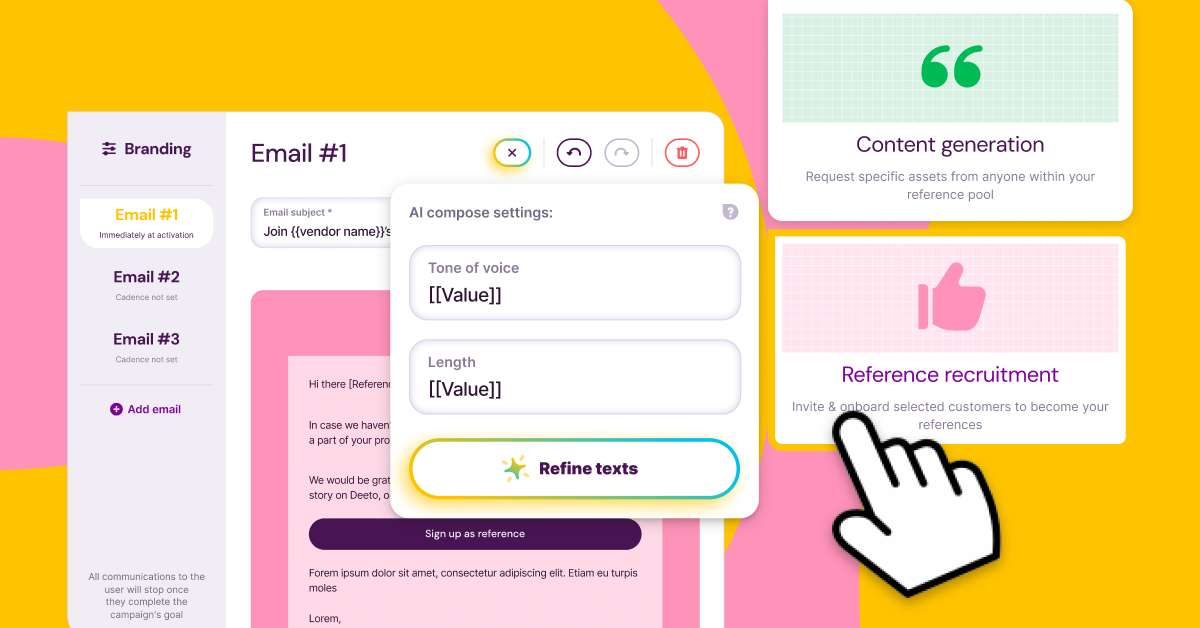
Maybe it goes without saying, but customer engagement platforms are not all built the same. The right tool does more than just send messages. It'll help you understand, engage, and retain your customers (at scale).
Here are the key features to look for:
More than 7 in 10 of today's customers expect experiences tailored to their needs. In the age of AI, this is easier than ever.
Great platforms use AI to analyze behavior, segment users, and deliver personalized messages automatically, based on what each customer actually cares about.
Think: Product recommendations, custom email flows, and smart upsells without lifting a finger. Or, for your sales team, a smart-matching algorithm that shows reps the best-fit customers for reference calls and testimonials.
Your customers don’t live in one inbox. That's why top tools let you engage across email, live chat, SMS, social media, and even WhatsApp, all from one dashboard.
This keeps conversations consistent, no matter where they start. It also means no missed messages and faster, more reliable support.
Engagement without data is no better than guessing. The best platforms give you real-time insights into customer behavior, campaign performance, and touchpoints across the journey. You’ll know who’s engaging, who’s falling off, and what’s working, so you can make smarter decisions, faster.
Look for tools that sync with CRMs like HubSpot or Salesforce, as well as your sales, marketing, and support platforms. This eliminates data silos across your org and helps your team stay aligned with every customer interaction.
Manual follow-ups and reminders only work for small teams (and even then, they barely do).
Automation lets you scale. From onboarding flows to re-engagement campaigns, the best customer engagement tools help you set up workflows once, then engage customers around the clock.
In the end, that means fewer dropped leads, better retention, and more time for your team to focus on strategy.
Without further ado, here are seven of the most powerful customer engagement tools that you can use to streamline customer interactions and get more out of your most valuable source of insights.
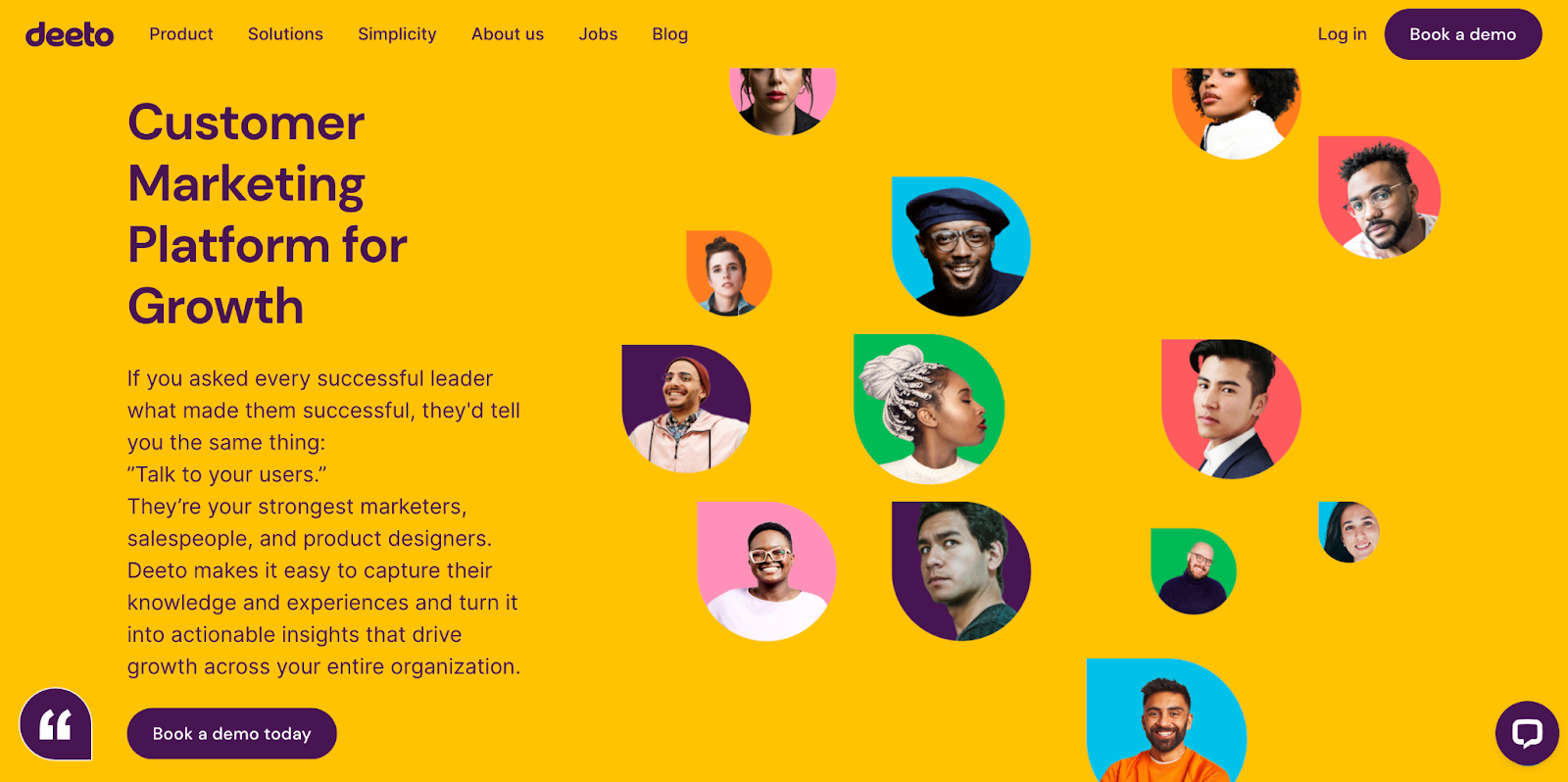
Deeto helps B2B companies turn happy customers into powerful advocates. You can use it to engage prospects better, deepen existing customer relationships, automate feedback collection, and drive smarter customer success decisions.
Instead of chasing testimonials, manually connecting prospects with references, or guessing which features are most important to customers, Deeto facilitates everything through smart, automated processes.
It's the all-in-one platform for customer-led growth, aligning Sales, Marketing, Product, and CS around the customer.
HubSpot (which includes Marketing Hub, Sales Hub, Service Hub, and CMS Hub) is an all-in-one platform that facilitates the broad, standard functions of your customer engagement strategy, like email marketing and customer service ticketing.
In 2025, it’s more powerful than ever, thanks to AI-driven automation, real-time analytics, and seamless collaboration across sales, marketing, and support.
Intercom is an AI-first customer engagement platform that helps SaaS companies deliver fast, personalized support through real-time conversations. It’s a great pick if your goal is to scale customer service specifically, without sacrificing quality.
Gainsight helps B2B SaaS teams prevent churn before it happens. It gives you the tools to monitor customer health, automate retention playbooks, and stay ahead of risks. That way, customer success becomes proactive instead of reactive.
Zendesk is built for fast, efficient customer support at scale. It helps businesses stay on top of tickets, reduce response times, and give customers the answers they need through live agents or AI-powered self-service. It's best for support teams that need to manage high ticket volume with efficiency.
Braze is a customer engagement platform brands use to deliver personalized, real-time messaging across every digital touchpoint. It’s built for teams that want to engage users with timely push notifications, in-app messages, and cross-channel campaigns (without writing code or switching tools).
Sprout Social facilitates customer engagement across social media platforms and gives companies comprehensive insights into brand sentiment. It centralizes customer communication across all your social profiles (e.g., Instagram, Facebook, X). And it provides tools for audience targeting, publishing and scheduling social media content, analytics, and team collaboration.
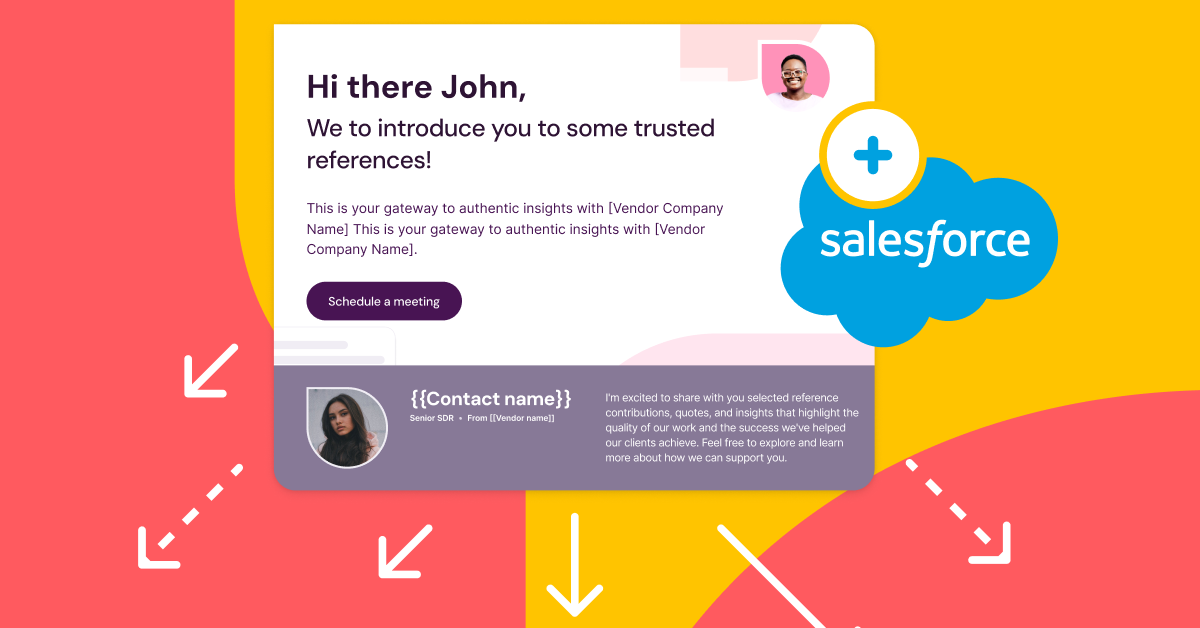
Most of the tools we mentioned facilitate broader workflows, like customer engagement through social media or support channels. But they’re just parts of the broader customer engagement workflow. They leave a gap after the sale closes.
What happens then?
That’s where Deeto comes in. It helps you:
It helps you maximize customer engagement by filling the missing link in your engagement stack. It turns your customers into your greatest growth engine. And it gives you a serious competitive advantage.
Request a demo today to see how Deeto can transform your customer engagement strategy.

Best Customer Engagement Platforms 2025: Top tools for managing customer relationships and driving success.
Customers aren't shy about voicing their preferences, frustrations, and ideas. Despite that feedback being one of the most valuable resources at their disposal, a surprising number of companies still overlook it (or fail to use it to its fullest potential).
According to research from TreasureData, 76% of business leaders say they're confident they have a complete understanding of their customers to deliver high-quality, personalized experiences. Only 25% of consumers agree.
But the customer experience is largely the deciding factor in your ability to retain customers and grow your business. More than half of all consumers say they'd switch to a competitor after just one bad one.
The best way to truly align your CX with customer expectations? Listen to the ones actually living it.
This is where a Voice of the Customer strategy comes into play.
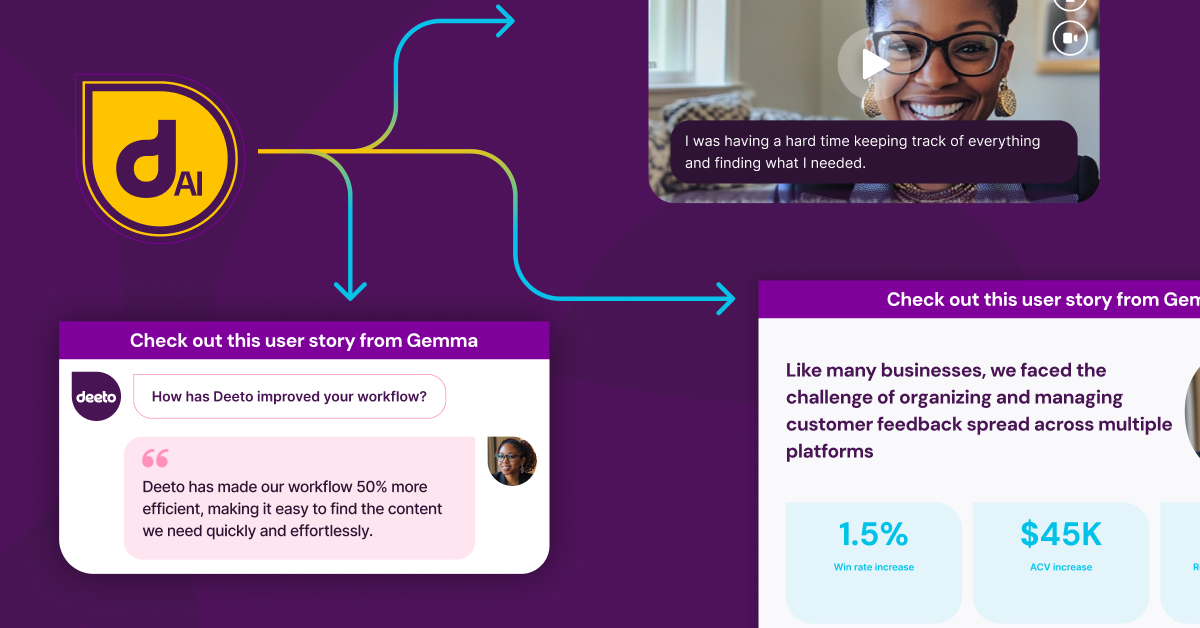
The Voice of the Customer (VoC) encompasses everything your customers are saying about your business: what they love, what frustrates them, what they wish you’d change. It's the systematic process of gathering, analyzing, and acting on customer insights to improve their experience and, ultimately, your bottom line.
Think of it like this: If you were running a restaurant, VoC would be more than just reading Yelp reviews. You'd want to know what people are ordering the most, how long they're waiting for their food, what they're expecting, and if they'd recommend your place to others. Then, you'd use that information to improve your menu, service times, and overall dining experience.
While customer satisfaction is a critical component of Voice of the Customer, it goes far beyond that.
VoC is all about gathering deep, ongoing insights into what customers are thinking, feeling, and expecting from your business. It’s proactive and holistic. You're gathering insights on behavior, pain points, and expectations from multiple sources.
Customer satisfaction is more like a snapshot. It measures how happy customers are at a specific moment (usually after a purchase, interaction, or service experience). Think of metrics like CSAT or NPS (Net Promoter Score). These are reactive, and they’re more focused on evaluating specific touchpoints rather than uncovering broader insights.
While customer satisfaction is an important piece of the puzzle, it’s just that — a piece. VoC gives you the whole puzzle, showing you why customers feel the way they do and how you can create better experiences across the board.
Collecting VoC data to tick a box doesn't tell you much about the "why" behind it. Active listening means really tuning in to what your customers are saying (and how they’re saying it).
Instead of just looking at the numbers and scores for these things, paying attention to the sentiment and language customers use gives you more context as to the emotions, motivations, and unspoken needs behind their words.
The Voice of the Customer is a strategic lever that directly impacts growth and profitability by guiding you toward customer-centric decisions. It allows you to anticipate and address their needs, pain points, and preferences, which ultimately leads to higher satisfaction, loyalty, and advocacy.
Your customers are the ones who use your products every day. That means they’re the first to spot what works, what doesn’t, and what’s missing. They can point out gaps or suggest features you may not have considered internally.
When customers repeatedly ask for the same thing or struggle with a similar issue, that’s your cue to act. Feeding this insight back into your product roadmap ensures you’re building things people actually want, which eliminates wasted dev time and increases adoption.
Businesses can't rely solely on product differences to stand out. The real differentiator is the quality of the relationship someone shares with a brand.
This is why nearly three in every four told Salesforce they'd switch to another brand for no reason other than a "better deal," while 88% said good service makes them more likely to purchase again.
VoC helps you identify pain points in the customer journey before they become dealbreakers. Maybe onboarding feels clunky or support takes too long. Whatever it is, when you consistently gather and respond to feedback, you show customers you care.
In turn, you'll have better retention, more referrals, and relationships that are harder to break.
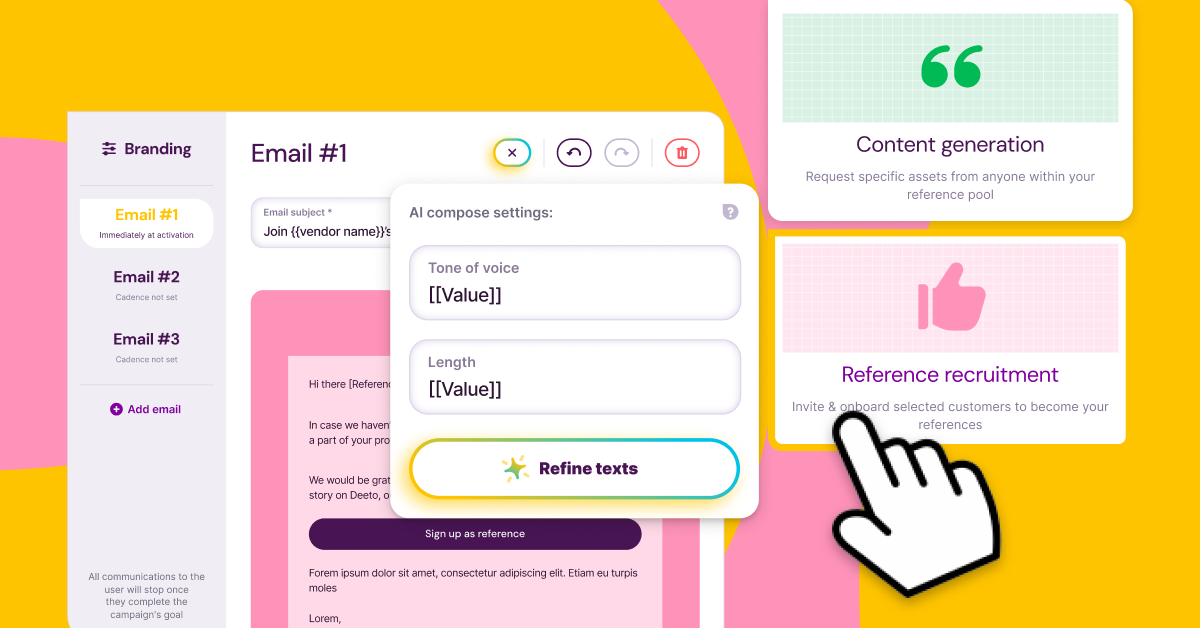
If you understand how your customers talk about your product and what truly matters to them, it's easy to mirror that in your messaging. That means clearer value props, better positioning, and more compelling campaigns.
Use VoC insights to refine your copy, identify high-converting language, and pinpoint the actual problems your product solves from the customer’s point of view. Sales teams can also use this intelligence to handle objections more confidently and tailor pitches more effectively.
With Deeto, the VoC data you collect can even be turned into social proof, which you can dynamically display on your website to increase web conversions.
Sometimes, your customers will reveal use cases or needs you didn’t realize your product could solve. These are golden opportunities — not just for new features, but possibly new offerings, markets, and competitive positioning.
In your VoC data, look for those outlier comments or recurring “It would be great if…” moments. Those point to areas where you can create add-ons, premium tiers, cross-sells, or spin-off solutions that align with your customers’ evolving needs.
By the time a customer cancels, it’s usually too late. But if you’re listening closely, the warning signs are there.
VoC helps you address those red flags early. Maybe it’s a check-in call, a targeted email, or a product tutorial. Whatever it is, proactive engagement helps them get value out of their relationship with your product.
To lay the groundwork for a successful strategy, there are four important steps you need to take when setting up your VoC program:
You need to know what you’re listening for. Otherwise, you’ll end up with a bunch of data and no clear direction. Goals give your VoC program purpose.
Start by asking: What are we trying to improve? Are you trying to reduce churn? Improve a product feature? Nail your brand messaging?
Once you have clarity, define measurable goals (like improving CSAT by 10% or increasing trial-to-paid conversion). These goals guide everything else, from what questions you ask to which channels you focus on.
Not all feedback carries the same weight, and different customers have different needs. To understand who you’re hearing from and make sure you’re acting on insights that actually matter to your business strategy, your second step is to segment your audience.
Build personas that reflect these groups and their goals. Then tailor your questions and analysis accordingly. That way, you avoid treating all feedback as one-size-fits-all and start making decisions that are laser-focused on specific customer groups.
You need both the right channels and the right timing to get meaningful, actionable feedback. If you’re only using surveys, you’re missing the bigger picture.
The best approach is to mix methods:
You’ll want a blend of quantitative data (scores, trends) and qualitative insights (comments, conversations). Together, they give you both the “what” and the “why.”
Data spread across tools and teams is noise. You need one source of truth that turns scattered input into clear insights.
Use a centralized platform for capturing customer knowledge and feedback (like Deeto), or a CRM-integrated solution that pulls in feedback from all your channels. Tag and categorize data, then analyze it on a regular basis to find trends, flag issues early, and continuously refine based on what customers are telling you.
Like I mentioned, tapping into the Voice of the Customer requires a healthy mix of quantitative and qualitative data from a variety of sources.
Broadly speaking, there are five categories of customer feedback to use:
These are your workhorses. They’re scalable, structured, and perfect for capturing specific feedback at key moments (like post-purchase or post-support interactions).
Ideally, keep them short and focused. Ask both quantitative questions (“On a scale of 1–10…”) and open-ended ones (“What could we have done better?”).
Tools like Typeform, Google Forms, or SurveyMonkey make it easy.
Pro tip: Personalize surveys based on customer segment or journey stage to keep things relevant.
This is where you go deeper.
Interviews let you explore emotions, behaviors, and underlying motivations you won’t uncover in a form. To avoid bias, start by choosing a diverse sample of customers and create a relaxed environment where they can be candid. Ask open-ended questions and actively listen.
Focus groups are great for getting multiple perspectives at once and watching how ideas bounce around. They're gold for product development, UX research, and branding insights.
Social platforms are an unfiltered feedback channel; people say what they really think about your brand and product, in real time.
Use tools like Brandwatch, Hootsuite, or Sprout Social to monitor brand mentions, hashtags, and sentiment. Pay attention to trends, complaints, praise, and what they're saying about competitors.
Reviews are unsolicited, brutally honest, and loaded with insights about what people value most. They also highlight emotional drivers that formal feedback might miss. Track your reviews on platforms like Google, G2, Yelp, or whichever platforms are relevant to your industry.
Look for patterns in language, tone, and specific features being mentioned. High ratings tell you what to double down on. Low ones? They’re a free roadmap for improvement.
People usually reach out when they’re stuck, confused, or frustrated. So, your support inbox shows you in real time where your points of friction are.
Analyze tickets, chat logs, call transcripts, and feedback forms. Tag and categorize issues by type, frequency, and sentiment. Better yet, loop your support team into the VoC process, since they’re on the front lines and know what’s bothering customers through first-hand experience.
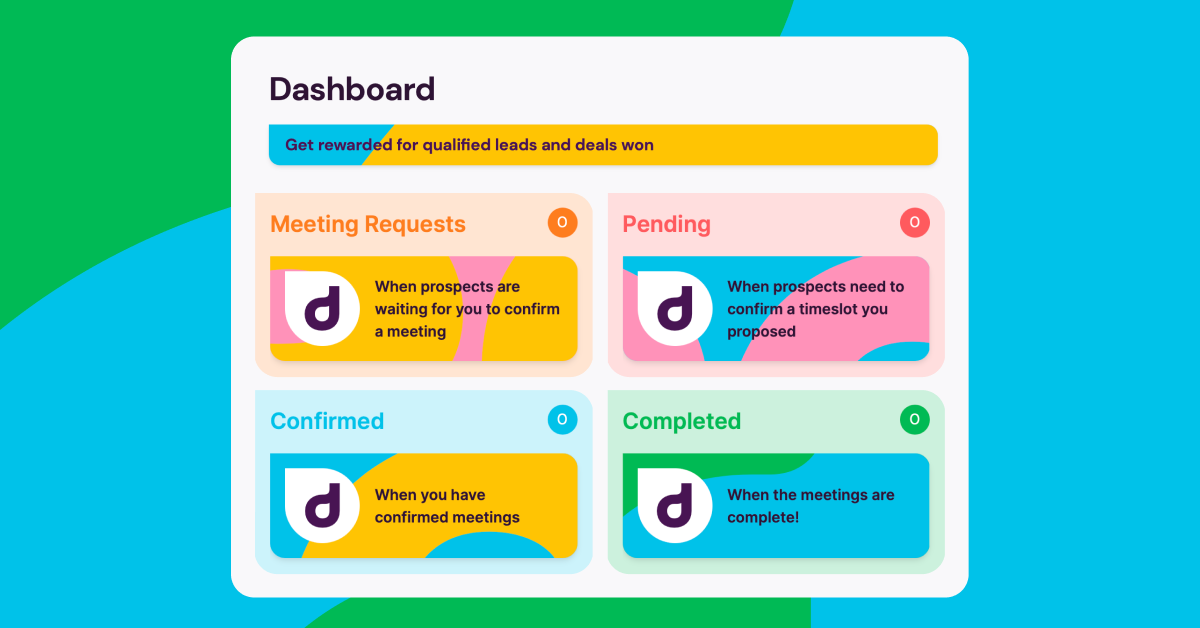
Tracking the right KPIs helps you connect feedback to action and measure whether your efforts are actually making a tangible impact.
Here are seven key metrics you’ll want to keep an eye on:
Your VoC strategy is where the rubber meets the road. To create a structured, repeatable process that ties customer feedback directly to business outcomes, there are five key steps to follow:
Start by identifying your core strategic objectives. Are you trying to break into a new market? Reduce churn? Improve onboarding?
Once you’ve nailed those down, Deeto simplifies feedback collection by allowing your customers to share it directly. When you invite them to the platform, they instantly become part of your knowledge base.
Not all feedback carries equal weight. Feedback from a high-LTV or long-time customer might reveal deeper loyalty drivers or critical gaps, especially if they're aligned with your ICP. Segment insights so you’re not optimizing for edge cases or low-impact voices.
Also pay close attention to patterns. If 20% of your customers flag the same issue, that’s probably a high-impact opportunity.
Analyze the data to uncover trends, root causes, and opportunities. Group comments by themes (e.g. pricing, usability, support) and tie them back to your goals. Then create clear, specific recommendations your team can act on — for example, “redesign the signup flow to reduce confusion” instead of “people are getting stuck.”
Work with Product, Marketing, Support, and Ops teams to turn insights into roadmap items, experiments, or process improvements. Set timelines, assign ownership, and track progress for each.
Small changes (like updating onboarding emails) can be quick wins, while larger changes (like building a new feature) need more planning, but both matter.
In VoC, active listening also means you respond. You acknowledge the feedback, you act on it, then you let customers know you've implemented a solution. One way to do this is to send an email saying “You asked, we listened," highlighting what’s new and thanking them for their input.
With Deeto, knowing who is responsible for which feedback is easy because everything is tagged by name and segment. It also integrates with your CRM, so you can reach out directly to the customers who gave feedback without having to manually search for their contact information.
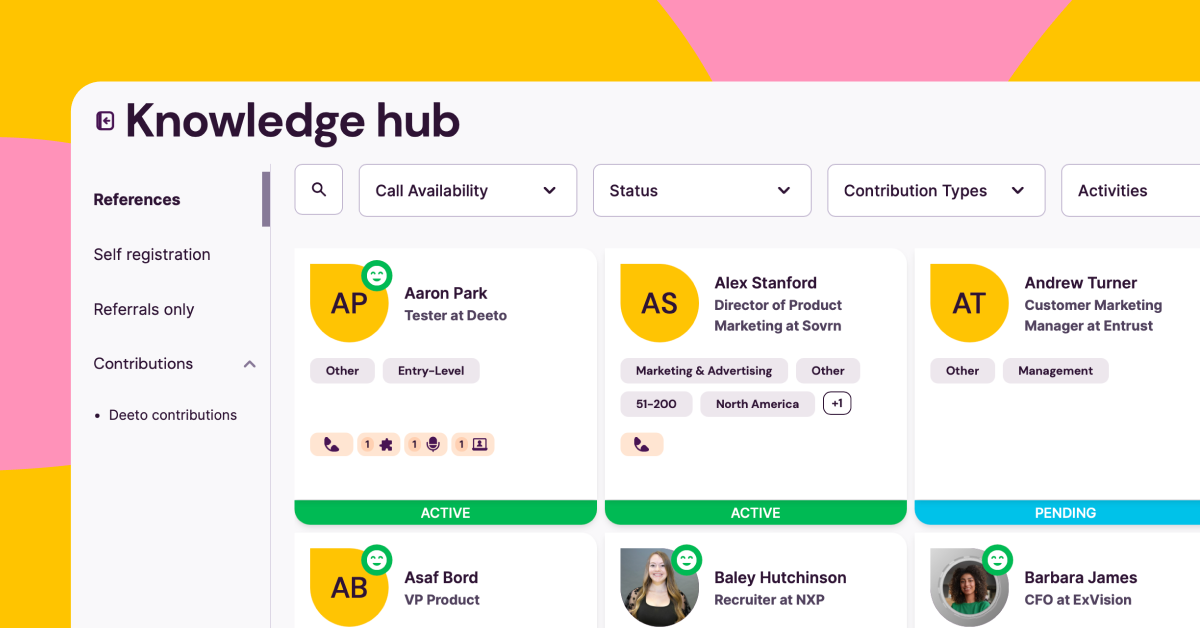
Timing, application, and analysis make the difference between “meh” insights and truly actionable ones. To implement the steps I've mentioned above, there are a few important best practices to keep in mind:
Even with those best practices, you'll probably run into four main issues when you're implementing and scaling your VoC program:
Let's take a closer look at some possible solutions to these issues:
One of the biggest challenges for VoC programs is getting enough responses to make the data statistically significant.
Increase your response rates:
A platform like Deeto makes things easier because customers leave their knowledge and insights directly within the app, and it's as easy as making an Instagram post.
Open-ended feedback, reviews, and support tickets pile up fast—and it’s hard to make sense of them manually.
The solution here is to use AI-powered text analytics or sentiment analysis tools, which can help you categorize, tag, and analyze the feedback at scale. Build a tagging system or feedback taxonomy to organize themes, then routinely extract the top 3–5 insights per channel to stay focused.
When internal processes move slow, the insights customers give you lose momentum.
To fix this, assign VoC "owners" in each department who can triage and route feedback for particular categories. For instance, at-risk customers can be routed to Customer Success while major bug reports can go to your Product team.
Maybe you collect great insights but struggle to apply them to personalized marketing, onboarding, or product experiences.
If you tie VoC data to your CRM or customer profiles, you can use the feedback to build smart segments (e.g., “frustrated new users,” “loyal customers who want X feature”). From there, customize content, offers, or product flows based on that segmentation.
You can use Deeto's AI-powered segmentation tools to curate and suggest the most valuable content for each specific use case or customer interaction.
It's more than just a platform you can use to collect, centralize, and track VoC insights. It's an end-to-end customer marketing platform, meaning you can take different kinds of feedback from different kinds of customers and apply them to different areas of your business.
Customers choose how they want to contribute, so there's no "right" or "wrong" way to provide feedback. This makes it easier for you to get more insights from a wider variety of customers.
And our AI-powered tools make it easy to segment and track different types of feedback, create usable content (e.g., case studies), and connect customers with prospects in your pipeline based on their knowledge and first-hand experiences.
Request a demo to see how it works.

Learn what Voice of the Customer (VoC), how it works, key methods, best practices, and strategies to improve growth.
Organic growth is a fantastic way to build your business. Growing a business organically means using customer-driven strategies instead of paid advertising. This prioritizes long-term sustainability, trust, and customer engagement to increase brand loyalty and reduce acquisition costs.
An organic growth strategy also allows you to scale efficiently by leveraging existing customers, word-of-mouth referrals, and quality-driven strategies rather than expensive marketing campaigns.
Unlike paid growth strategies—which often yield short-term gains—organic growth emphasizes long-term success through trust, credibility, and consistent value delivery.
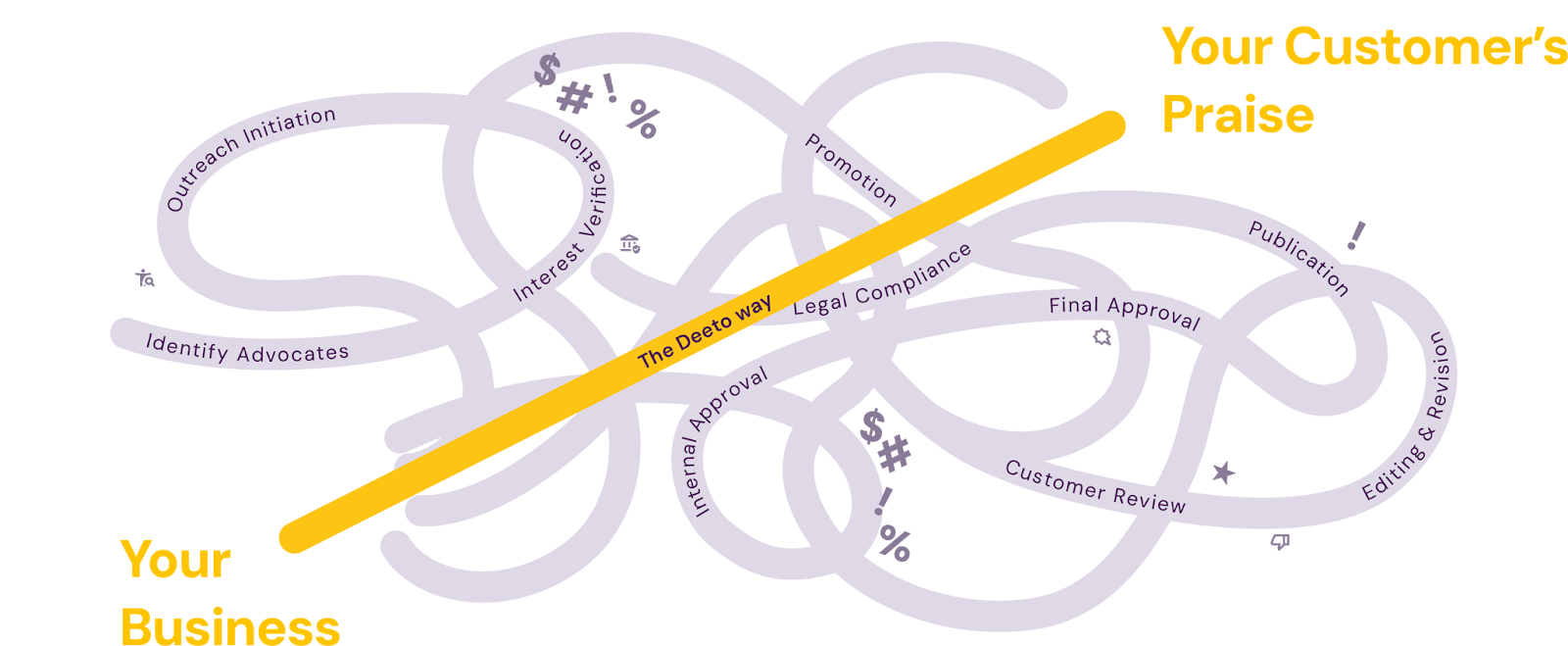
Organic growth is business expansion achieved through customer retention, referrals, and word-of-mouth marketing rather than paid advertising. It focuses on sustainable growth, authentic relationships, and long-term customer value.
If your organization achieves organic growth, you’ll build customer satisfaction and brand advocacy. You’ll also create valuable experiences that often keep customers.
Customers prefer brands that offer genuine interactions rather than aggressive sales tactics. Transparency, ethical business practices, and value-driven messaging help establish trust, which makes customers more likely to stay loyal.
Businesses that focus on providing real solutions—rather than just pushing sales—build deeper connections with their audience. In addition, customers appreciate brands that prioritize their needs, leading to repeat purchases and long-term loyalty.
Strong, lasting customer relationships translate to higher brand advocacy and organic referrals. This reduces dependence on expensive customer acquisition methods, making growth more sustainable in the long run.
An organic growth strategy isn’t just important for businesses, but it’s also important for customers. Let’s look into some reasons why:
Loyal customers contribute more revenue over time through repeat purchases and referrals. Businesses that focus on customer retention see greater profitability without increasing acquisition costs.
An organic growth strategy leverages existing customers, reducing the need for expensive marketing campaigns. Instead of constantly spending on acquiring new customers, businesses can focus on nurturing and expanding their current customer base.
Strong customer relationships translate into positive reviews, higher credibility, and a brand image that attracts new customers organically. A well-respected brand naturally gains traction in the market.
Happy customers naturally promote your brand to their networks, fostering organic expansion. A strong referral network can significantly boost sales and customer trust.
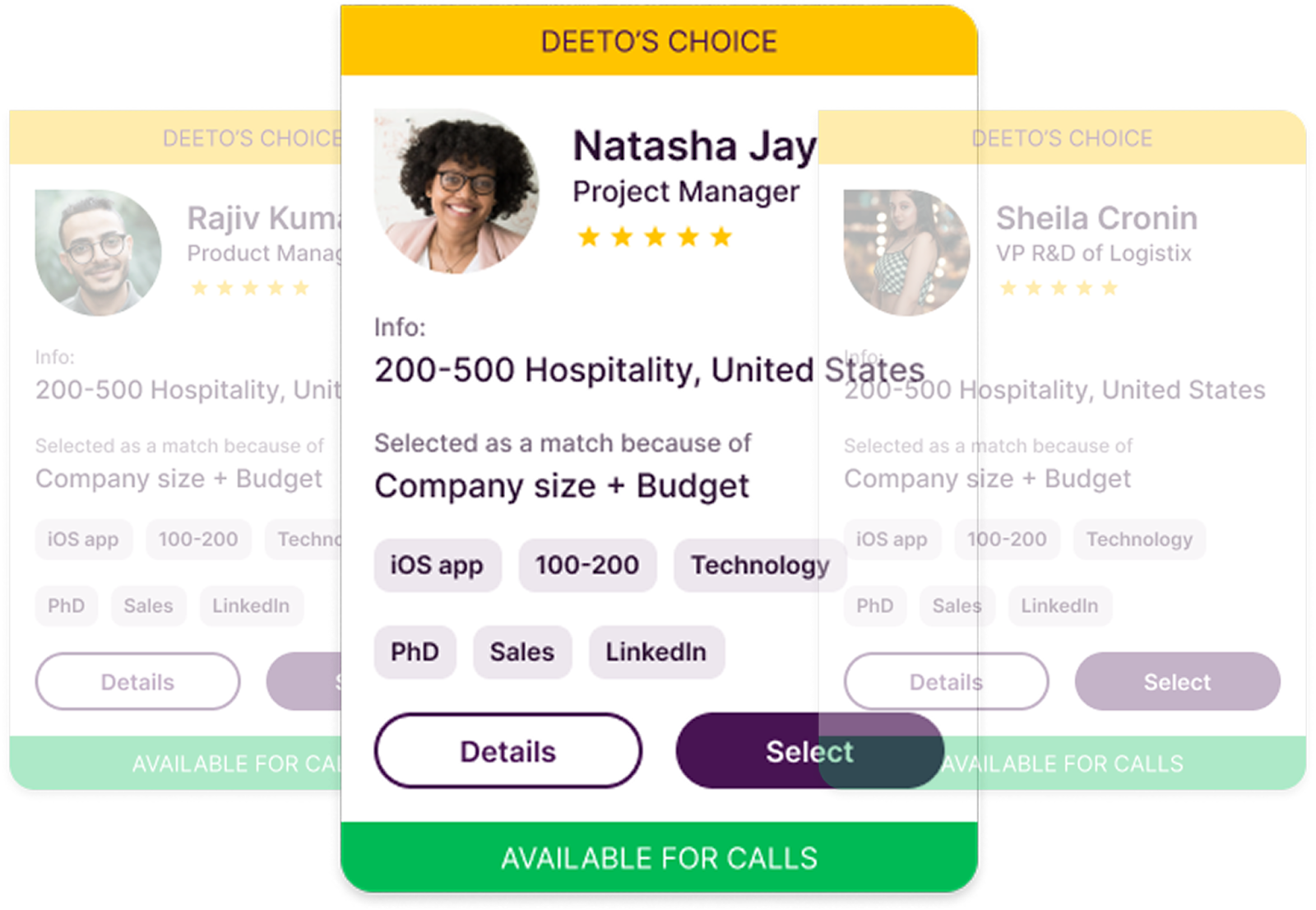
It’s crucial to identify the touchpoints. Understanding where and how customers interact with your brand helps optimize the user experience.
You must also understand customer needs at each stage. Addressing pain points and providing solutions at each phase of the customer journey ensures higher satisfaction.
First, you must optimize for user experience (UX). This means ensuring easy navigation, responsive design, and clear messaging to improve customer satisfaction.
You must also provide exceptional customer service—including quick resolutions, attentive support, and proactive engagement to build trust.
Furthermore, it ensures personalization and customization. Tailoring experiences to individual preferences increases engagement and customer happiness.
Customer feedback provides insights to refine products, services, and overall experience. You should encourage reviews and act on customer input to demonstrate a commitment to continuous improvement and customer satisfaction.
Creating valuable and informative content is essential for positioning your brand as an industry leader.
If you offer blogs, whitepapers, webinars, and educational resources, your brand can share insights that resonate with your audience and showcase expertise. This approach not only helps establish authority but also attracts potential customers who need trusted guidance.
Thought leadership also plays a crucial role in building credibility. As you share your expertise, you position your brand as a reliable source of information. This trust can significantly impact customer acquisition and retention, as customers are more likely to choose a brand when they see an expert in its field.
Open and honest interactions are at the core of building lasting relationships with your customers.
Transparency builds trust and shows that your brand values clear communication and is committed to being upfront about its practices and policies. This openness encourages customers to feel more connected and confident in their choice to engage with your brand.
Additionally, addressing customer concerns promptly is essential in demonstrating your commitment to service. When you respond quickly to issues, it reflects your brand’s reliability and dedication to customer satisfaction.
Customer testimonials and reviews play a critical role in building trust. Real experiences from satisfied customers help reassure potential clients that your brand delivers on its promises.
Positive feedback acts as a form of social proof, validating your brand’s credibility and attracting new business.
Case studies and success stories further enhance your brand’s credibility by demonstrating proven results. When potential customers see that your brand has successfully solved challenges for others, it increases their confidence in your ability to meet their needs.
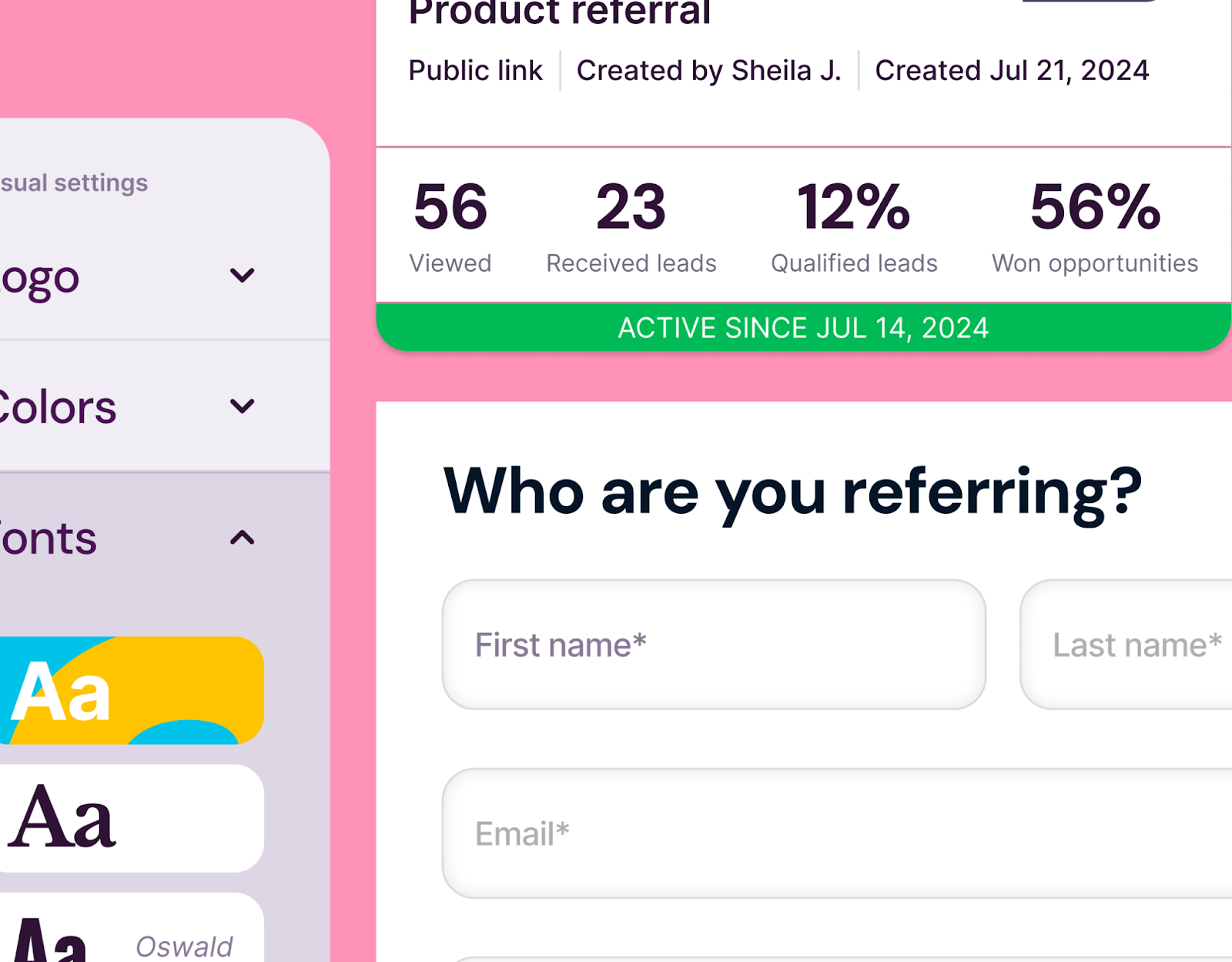
Book a Demo - Start Using Deeto AI
You should recognize and reward loyalty. You can achieve this with exclusive perks for dedicated customers to encourage repeat business and referrals.
There are many excellent ways to engage your customers. Let’s look at some of the best ways:
Timely responses to reviews demonstrate attentiveness and build trust. You must address feedback—both positive and negative—to show customers that their opinions matter.
Social media groups and forums are critical for growing your community. To strengthen customer relationships, you should create spaces for meaningful discussions and peer-to-peer support.
You should also consider events and meetups. It strengthens customer connections through real-life interactions and builds deeper loyalty.
You should ask questions and initiate discussions. Engaging customers directly makes them feel valued and involved. It’s also critical to respond to comments and messages. That’s because active engagement strengthens relationships and brand trust.
You should build a positive and inclusive environment. A welcoming community enhances customer satisfaction and retention.
In addition, you should celebrate community achievements. You can achieve this by recognizing customer success stories to strengthen emotional connections with the brand.
Failing to actively listen to customers can lead to missed opportunities for improvement and decreased loyalty. Customer feedback - whether through reviews, surveys, or direct interactions—provides invaluable insights into what’s working and needs adjustment.
Brands that dismiss this feedback risk losing touch with their audience, which leads to lower retention rates and stagnant growth.
You should establish feedback loops, actively respond to concerns, and adapt strategies based on customer input.
Many businesses focus heavily on acquiring new customers while neglecting the ones they already have. However, retaining existing customers is often more cost-effective than acquiring new ones.
Companies should implement retention strategies such as personalized offers, loyalty programs, and proactive customer support.
Regular engagement, follow-ups, and appreciation gestures (such as exclusive content or early access to products) can turn first-time buyers into lifelong advocates.
Attracting new customers is essential, but engagement is what keeps them coming back. Without meaningful interactions, even the most successful acquisition campaigns will result in high churn rates.
You should prioritize relationship-building through personalized communication, community-building efforts, and consistent value delivery.
Whether through social media interactions, educational content, or responsive customer service, ongoing engagement ensures customers remain connected to the brand.
Many businesses rely too heavily on paid advertising while neglecting organic marketing efforts. A well-rounded strategy includes SEO, content marketing, social media engagement, and email marketing. These channels drive sustainable traffic and enhance brand credibility.
High-quality blog posts, informative videos, and interactive social content can attract potential customers and nurture existing ones.
Businesses that fail to invest in organic channels struggle to establish long-term visibility and authority in their industry.
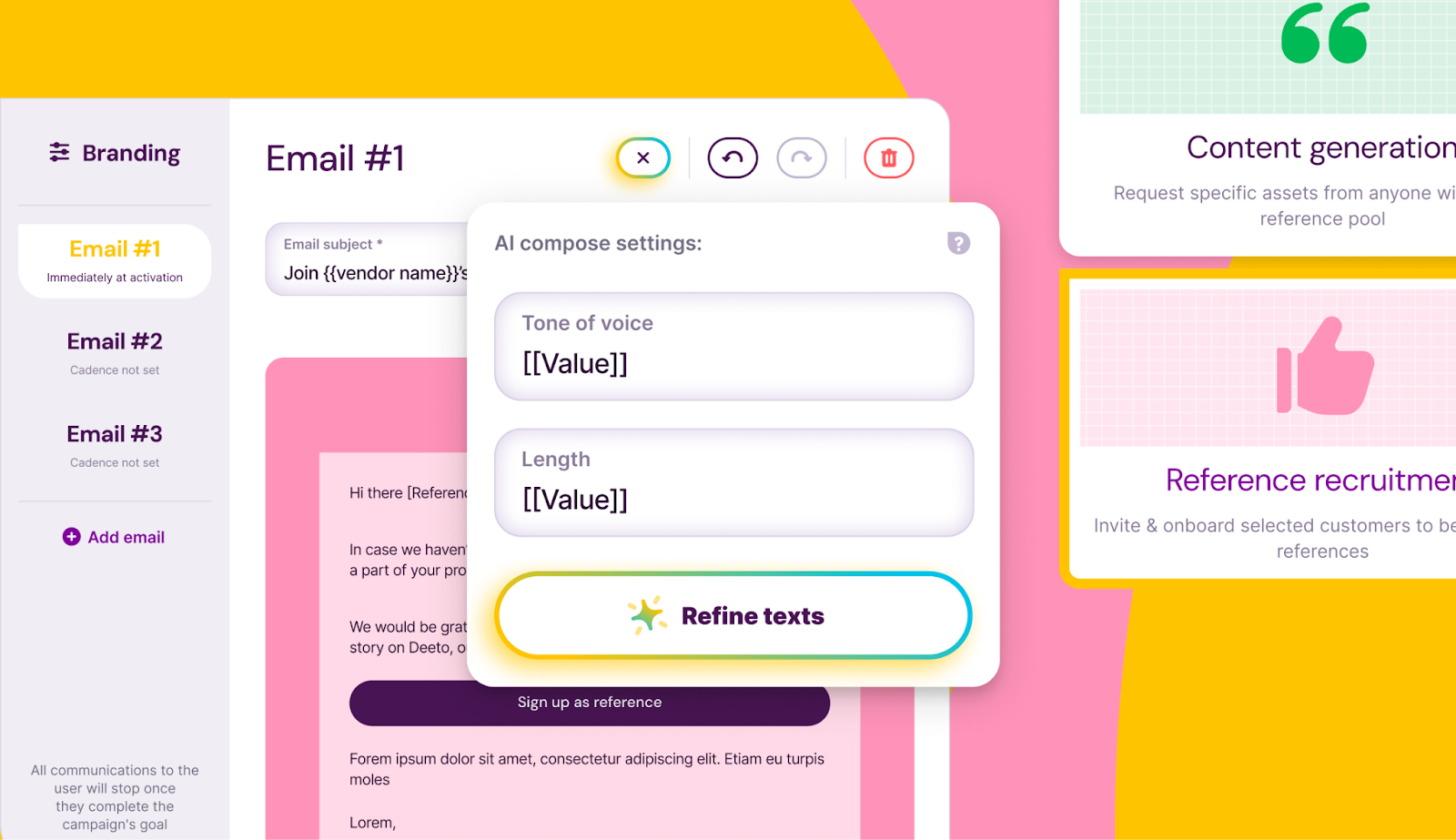
Deeto streamlines the process of engaging your customer base and transforming their insights into valuable assets for your sales, marketing, customer service, and product teams.
With centralized data and AI-driven insights, it simplifies connecting with prospects at scale and ensures communication is authentic. Schedule a demo today to see it in action.

Discover how to grow a business organically using customer-driven strategies and word-of-mouth marketing
Customer-led growth (CLG) is a strategy that focuses on customer experiences, feedback, and advocacy to drive success. Instead of relying on aggressive sales tactics, CLG uses customer insights to improve product development, engagement, and retention.
Companies that use CLG benefit from organic word-of-mouth marketing, deeper customer connections, and improved brand credibility—all key ingredients for success.
In this article, we will explore the benefits of CLG, key strategies, and how AI-powered tools, such as Deeto.ai, can make you a customer-led business.
Customer-led growth is a strategic approach for centering your growth initiatives. It focuses on customer needs, behaviors, and feedback. Engaging customers as decision-makers can build loyalty, drive organic referrals, and sustain long-term revenue growth.
All in all, a customer growth strategy is an excellent way for your organization to grow.
When you understand and meet customer needs, satisfaction naturally follows. Happy customers often remain loyal, which reduces churn and creates long-term relationships.
To grow customer loyalty, you should offer personalized experiences, timely support, and ongoing engagement.
Engaged and satisfied customers become powerful brand advocates. They willingly share their positive experiences with others and influence new prospects through word-of-mouth, online reviews, and social media.
In return, these customers can significantly impact your brand’s reputation and drive organic growth.
Customer-led growth thrives on continuous feedback loops. When refining or creating new products, listening to customer insights and understanding their pain points can provide invaluable knowledge.
As such, this customer-centric approach keeps you ahead of the curve, adapts to changing needs, and delivers innovative solutions for your target audience.
Growing customer loyalty and advocacy has a direct correlation with long-term profitability. That’s because loyal customers contribute to repeat sales and spend more over time.
In response, it creates a sustainable cycle where investment in customer relationships leads to a steady income.
In today's crowded markets, standing out is a challenge. However, you prioritize customer-led strategies to demonstrate your commitment to understanding and adapting to your customers’ needs.
This differentiates you from competitors focusing on traditional marketing tactics.
Customer-led growth reduces heavy spending on traditional marketing and paid acquisition strategies. When happy customers spread the word through referrals, testimonials, and organic social media engagement, they attract new prospects at a fraction of the cost of paid ads.
Moreover, customers trust recommendations from peers far more than they do branded advertising.
A company that consistently listens to and values customer feedback earns trust, which is a powerful asset in today’s competitive market.
When customers see that a brand is responsive to their needs—whether through personalized interactions, timely support, or meaningful product updates—they develop a sense of confidence in the brand’s reliability.
Sales-driven models have some significant downsides, including short-term focus and poor adaptability.
Let’s break these down:
At the heart of CLG is a fundamental shift in how businesses perceive and interact with their customers. Rather than treating customers as mere transactions, CLG places them at the center of its business strategy.
You can use this feedback in product development, marketing, and customer experience strategies to create highly relevant offerings.
Encouraging customers to become brand advocates is a pillar of CLG. When satisfied customers share their experiences through testimonials, case studies, and referral programs, they build social proof for your brand.
In addition, advocacy programs encourage word-of-mouth marketing, which turns loyal customers into growth drivers. It achieves this by influencing potential buyers and expanding brand reach organically.
Creating a strong community around your brand develops deeper relationships and a sense of belonging. For instance, online forums, social media groups, or exclusive customer events provide a space for customers to connect, share experiences, and provide feedback.
Active engagement within these communities keeps you connected with customer needs and gains real-time insights into user preferences.
Modern customers expect personalized interactions that match their preferences, behaviors, and past interactions.
You can use AI-driven segmentation, behavioral tracking, and customized messaging to boost personalization. As a result, this creates meaningful connections, higher retention rates, and increased customer satisfaction.
Utilizing customer data is essential for making informed business decisions. Advanced analytics provide data on customer behavior, pain points, and trends, which allows you to optimize your strategies.
Establishing structured mechanisms for collecting and acting on customer feedback ensures that you meet customer expectations. You can use surveys, Net Promoter Score (NPS) tracking, product reviews, and in-app feedback channels to gain insights for continuous improvement.
Deeto.ai enhances every aspect of a CLG strategy with AI-powered tools, such as customer sentiment analysis, predictive analytics, and engagement automation.
With real-time insights into customer satisfaction, preferences, and behaviors, Deeto refines your advocacy programs, personalises interactions, and builds stronger customer relationships, which drive sustainable growth.
AI-driven technology is revolutionizing businesses that implement customer-led growth strategies. You can deepen customer relationships, enhance engagement, and drive sustainable growth by leveraging AI-powered insights, automation, and predictive analytics.
Understanding customer emotions and perceptions is crucial for building strong relationships.
Deeto.ai uses AI to analyze customer feedback from multiple touchpoints, including surveys, social media interactions, and support tickets.
Anticipating customer needs is key to delivering personalized experiences and preventing churn.
Deeto.ai’s predictive analytics engine forecasts customer behavior. It helps you identify at-risk customers, recommend proactive solutions, and tailor engagement strategies.
One-size-fits-all marketing is no longer effective. AI-driven personalization can deliver highly relevant content, product recommendations, and promotional offers based on individual customer preferences and behaviors.
With Deeto.ai, you can create dynamic, customer-centric experiences that drive engagement, increase conversions, and grow long-term loyalty.
Fast and efficient customer support is a critical component of CLG.
Deeto.ai’s AI-powered chatbots and automation tools streamline support processes, reducing response times and improving the overall customer experience.
Brand advocacy is one of the most powerful drivers of organic growth. Thankfully, Deeto.ai identifies highly engaged customers likely to become advocates and regular customers.
Measuring the success of a customer-led growth strategy requires tracking key metrics that reflect customer engagement, satisfaction, and advocacy.
Here are some of the key metrics:
CLTV measures the total revenue you can expect from a single customer throughout their relationship with the brand. A high CLTV indicates strong customer retention, repeat purchases, and long-term profitability.
With improvements in customer satisfaction, personalized experiences, and building loyalty, you can increase CLTV and maximize the return on customer acquisition investments.
NPS assesses customer loyalty and their likelihood to recommend a product or service to others. It’s measured through a simple survey question, such as:
"How likely are you to recommend our product/service to a friend or colleague?"
Respondents are classified as ‘Promoters, Passives, or Detractors’. A high NPS suggests strong customer advocacy, but a low score may indicate dissatisfaction or unmet expectations.
The churn rate tracks the percentage of customers who stop using a product or service. A rising churn rate signals potential issues with customer satisfaction, the onboarding process, or product value.
That said, if you analyze churn trends and implement proactive retention strategies—such as personalized outreach, loyalty programs, and enhanced customer support—you can reduce attrition and improve long-term retention.
The customer advocacy rate measures the percentage of customers actively referring and promoting the brand. This includes participation in referral programs, writing positive reviews, or sharing experiences on social media.
A high advocacy rate indicates strong brand loyalty and organic growth potential. You can enhance advocacy with strong relationships, rewarding referrals, and engaging with customers via community-building efforts.
CSAT quantifies customer happiness based on surveys and feedback mechanisms. Typically measured through post-interaction surveys, CSAT helps you gauge immediate customer reactions to products, services, or support experiences.
A consistently high CSAT score reflects a positive customer experience. In contrast, lower scores may highlight areas needing improvement.
The Customer Engagement Score (CES) measures how actively and frequently customers interact with your brand, product, or service. You can track engagement through various metrics, such as login frequency, feature usage, content consumption, or time spent on the platform.
A high CES indicates that customers find value in your offerings and are more likely to stay loyal, make repeat purchases, and advocate for your brand.
Conversely, a low CES may signal a disengaged user base, potentially leading to higher churn rates.
Implementing a customer-led approach for experience-led growth comes with many challenges. To successfully transition, you must address internal resistance, optimize data utilization, and scale advocacy efforts effectively.
Here are some tips:
Shifting to a CLG model demands a fundamental change in mindset across the organization.
Companies must grow a customer-centric culture by:
A data-driven approach is at the core of CLG, but many businesses struggle with collecting, organizing, and making sense of customer data. This results in them not becoming a customer-led business.
To overcome this, companies should:
As businesses grow, maintaining and expanding customer advocacy programs can become complex.
To ensure advocacy efforts scale effectively, you can:
Several platforms have successfully implemented customer-led growth (CLG) strategies. These have helped businesses harness customer advocacy, engagement, and data-driven insights to drive sustainable growth.
Here are some examples:
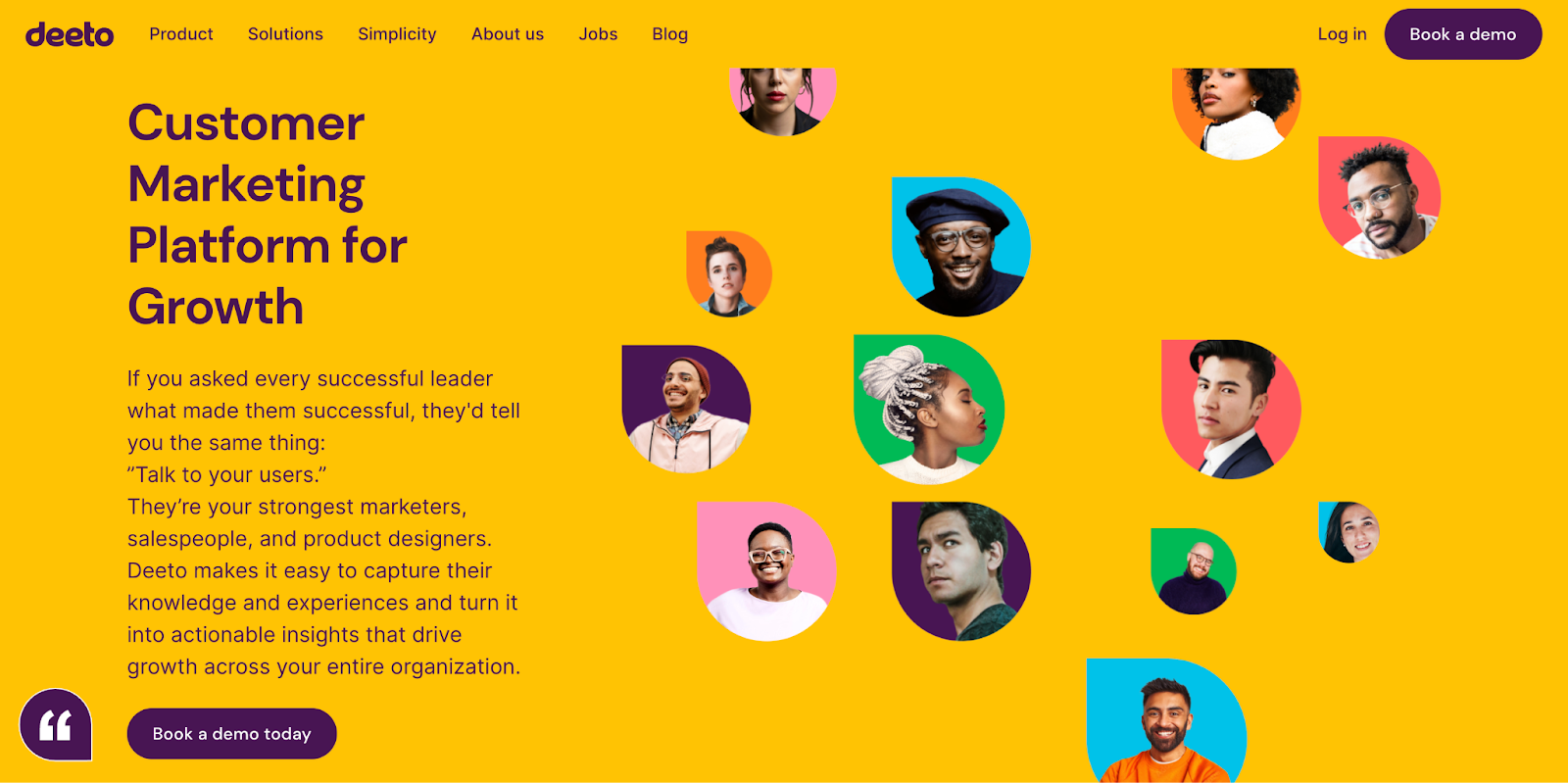
Deeto's all-in-one customer activation platform simplifies the process of collecting, organizing, and sharing valuable customer knowledge across your organization. From marketing materials and sales resources to experience data and product insights, everything's gathered and stored under one roof.
We also use our own software to support our own CLG initiatives by dynamically displaying social proof throughout our website, connecting prospects in our pipeline with relevant customer references, and bringing customers into the content creation and product development processes.
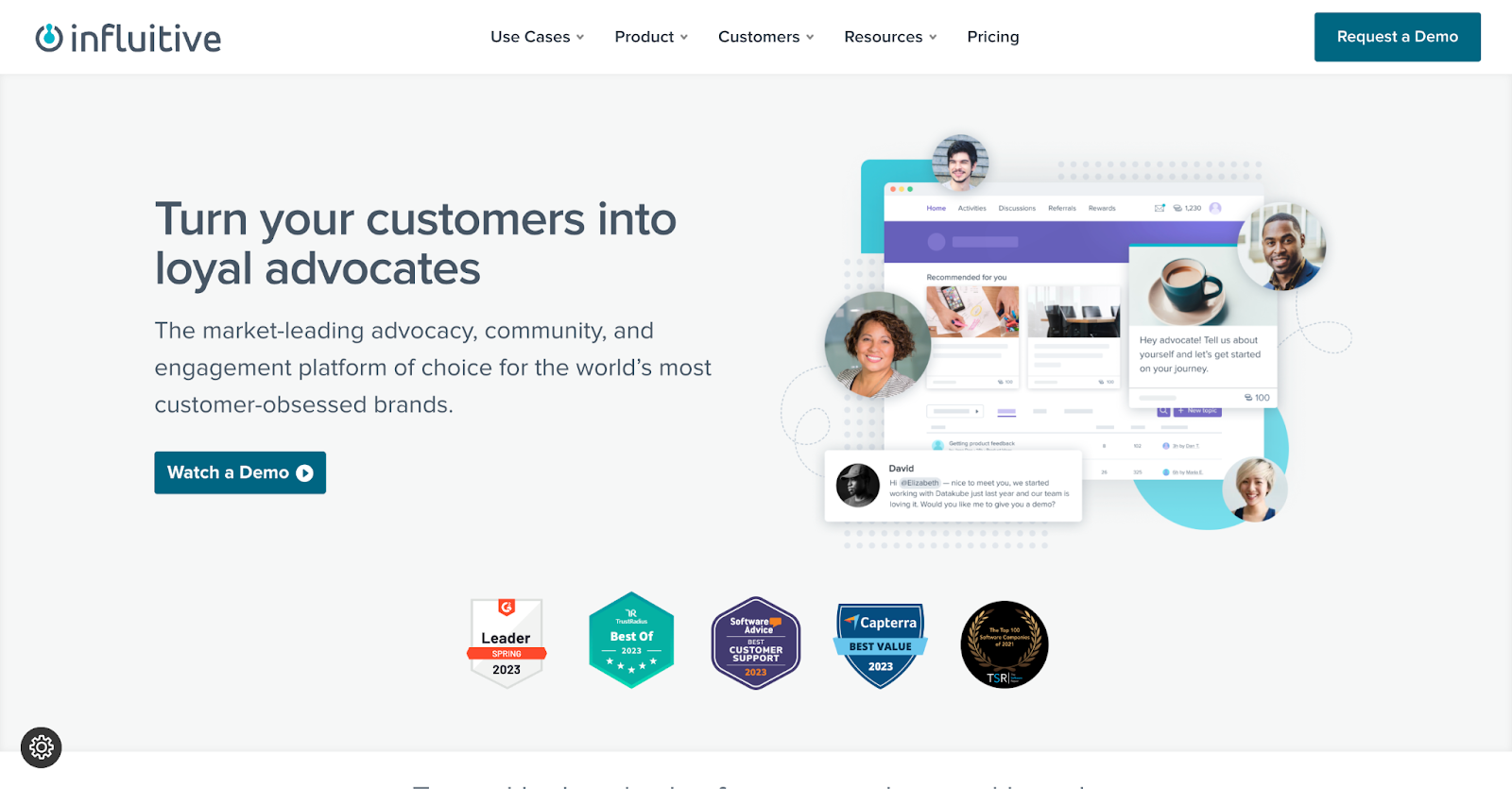
They specialize in customer advocacy and engagement, enabling businesses to build strong communities, incentivize referrals, and amplify word-of-mouth marketing.
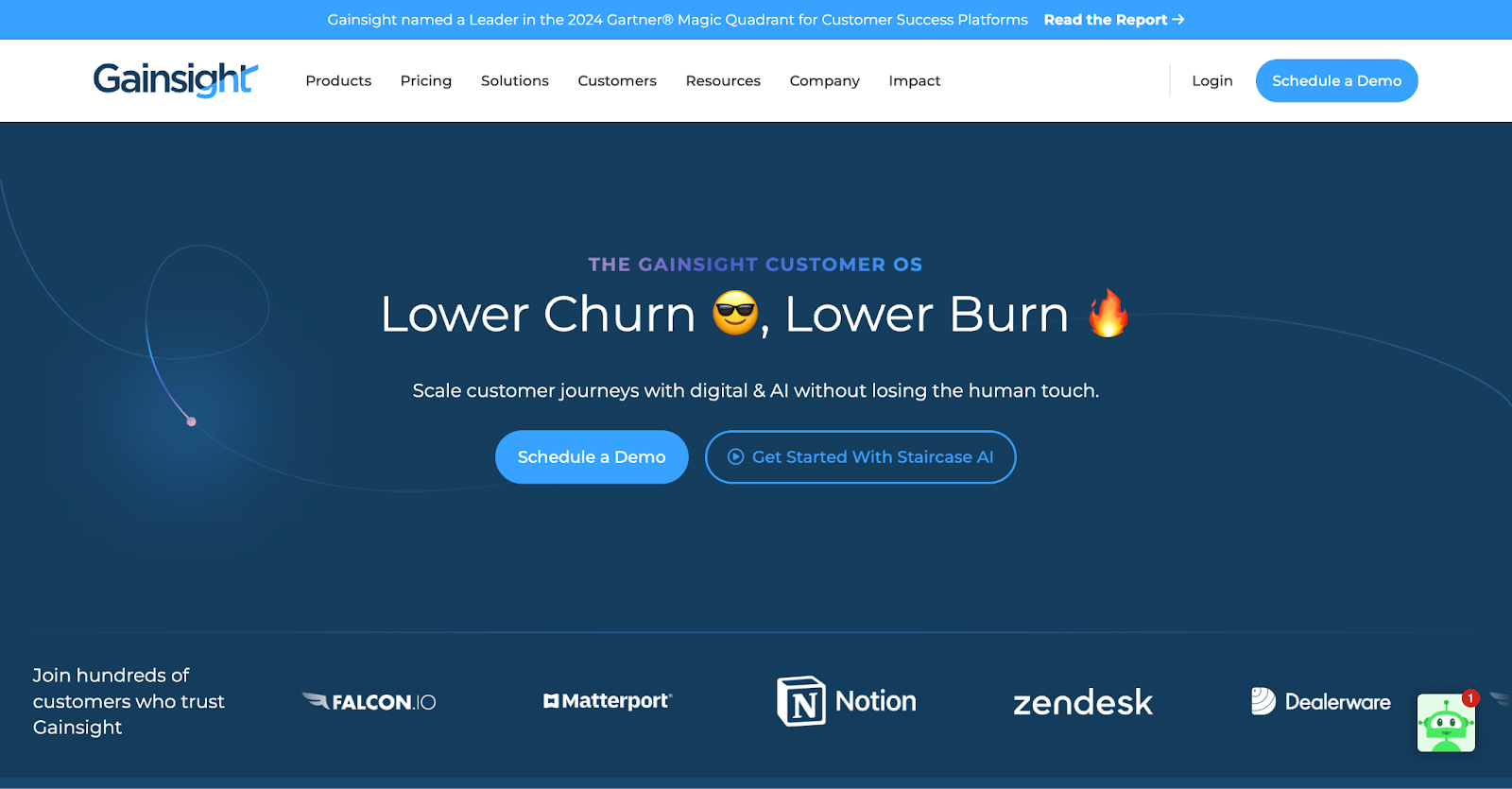
Focuses on customer success management, providing businesses with tools to improve retention, reduce churn, and drive customer satisfaction through proactive engagement.
Customer-led growth is the future of sustainable business success. If you prioritize customer insights, engagement, and advocacy, you will build loyal communities, drive organic growth, and stay ahead of the competition.
Deeto.ai provides the AI-driven edge to implement and scale customer-led growth strategies effectively. Book a demo and see how it works.

Learn what Customer-Led Growth (CLG) is, its benefits, and how businesses thrive with a CLG strategy.
If you're building out a sales team, you're either going to hire sales development representatives (SDRs) or business development representatives (BDRs).
Chances are, you've heard both terms thrown around quite a bit (at times, seemingly interchangeably). While they sound similar, their distinction is important when it comes to hiring decisions. Each position requires a unique set of behaviors, skills, and performance metrics.
Hiring the wrong type of sales rep causes confusion over responsibilities, inefficiencies in your sales pipeline, and underperformance if someone lacks the core strengths for the specific function.
In today's article, I'll walk you through the SDR's and BDR's roles within a company, their key differences, and how to know which one you need to hire for your sales org.
An SDR, or Sales Development Representative, is the person in your sales organization who identifies, qualifies, and engages potential customers before handing them off to an Account Executive or a more senior sales rep. Think of them as a “first point of contact” who breaks the ice with interested prospects.
Typically, they:
The SDR role engages and nurtures warm leads. They set the stage for more meaningful conversations down the line.
A BDR, or Business Development Representative, is your go-to person for finding untapped business opportunities and sparking conversations with companies that may not even know they need your solution yet. While an SDR deals with warm leads and inbound inquiries, a BDR is the hunter who goes out to create opportunities from scratch.
Some of their key responsibilities include:
BDRs expand your company's market reach by bringing new leads into your funnel. They get your product on the right people's radar, even before they start actively looking for a solution.
The main difference between an SDR and a BDR is that SDRs are focused on inbound leads, while BDRs are focused on outbound sales.
The number-one goal of sales development is to set qualified appointments with prospects who have a strong chance of converting into customers. Someone who meets this criteria is classified as a sales-qualified lead (SQL).
Business development, on the other hand, exists to create net-new revenue opportunities. The BDR's ultimate goal is to broaden the company’s horizons through fresh channels, business partnerships, and market segments.
Let's take a look at those differences more in-depth:
They’re looking for companies or markets you haven't fully tapped into yet (if at all). They start by identifying decision-makers and their roles/titles, then apply their knowledhe of industry trends, to figure out which companies stand to benefit the most from your offering. They base their outreach on simple identifiers like company size, location, and vertical.
Since the people they’re reaching out to haven’t necessarily raised their hands, BDRs start at a more basic level of qualification — that is, confirming whether there’s even a need for your product or service. By starting a conversation, they're essentially gauging (a) whether the prospect fits your ICP and (b) if the timing is right to move forward.
SDRs primarily focus on the people who’ve already shown interest in some way, like downloading a white paper, attending a webinar, or filling out a form. These leads are a step or two closer to buying, so SDRs don’t have to comb through entire industries. Instead, they talk with people who come in through existing marketing efforts (e.g., an ad or blog post).
Because of this, qualification is all about determining if that existing interest is a genuine fit. They can delve deeper into how the prospect’s challenges align with your solution and whether the lead meets your company’s “sales-ready” criteria. If the lead checks those boxes, the SDR sets up an appointment or demo with an Account Executive to keep the conversation rolling.
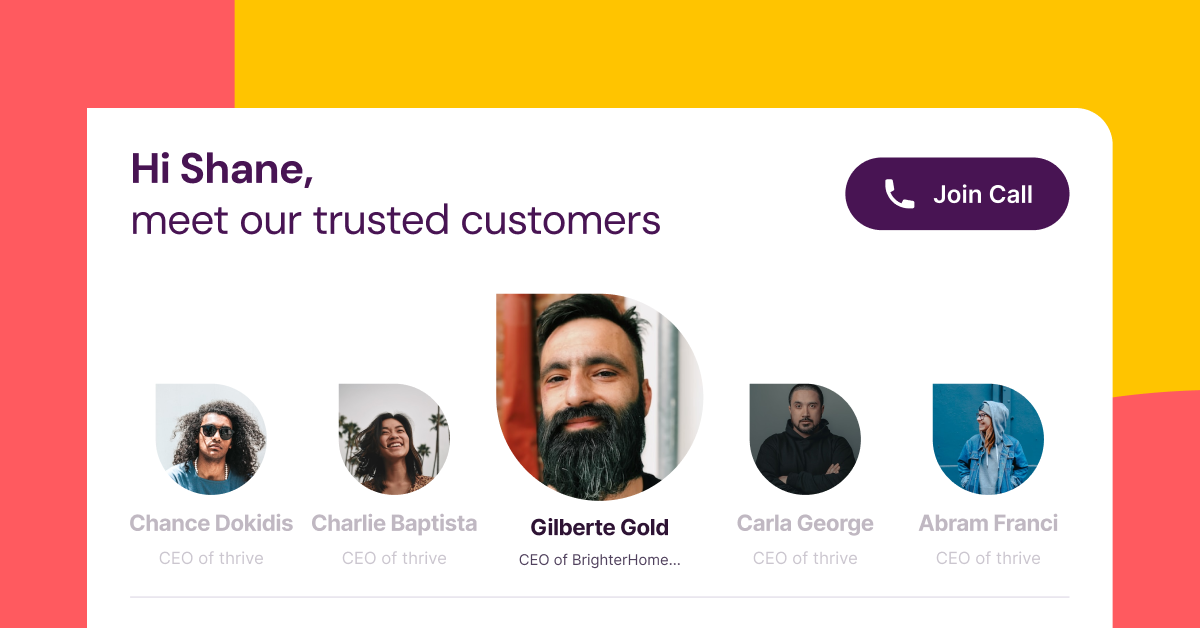
BDRs' prospects aren’t actively looking for a solution, so they spend time researching both the company and key stakeholders to create highly relevant messages that stand out. From there, they use cold outreach strategies to
Building relationships from scratch takes time — it takes an average of 8 touchpoints to land an intial meeting. So BDRs also develop a sales cadence (a planned sequence of outreach activities) that combines emails, calls, and social media outreach at strategic intervals.
Inbound leads are “warm,” so SDRs respond quickly (often within minutes or hours) to capitalize on that initial interest. Since these leads have already engaged (e.g., by requesting info), they focus on confirming fit and readiness rather than persuading someone to explore a solution from zero.
While the conversion cycle is shorter, SDRs still use a combination of phone calls, emails, and digital follow-ups to keep leads engaged and move them toward a productive conversation with an AE.
There are three main ways BDR managers measure and evaluate their teams:
As for sales development reps, activity metrics like call volume are also important. But, since they're dealing with warmer prospects, there are three other critical metrics to pay attention to:
A BDR's prospects might be aware your product exists, but they (usually) aren't actively looking for a solution. The BDR's job is to get them interested. They're there to get the prospect talking about their challenges and see if there's a way your product can help.
SDRs bridge the gap between marketing and sales. Their prospects have already looked at some of your marketing content and are somewhat familiar with your product. Some might even have requested a demo or trial. In this case, the BDR's job of filling the top of the funnel has already been taken care of by your marketing activities.
SDRs and BDRs are both part of an inside sales team. Both roles do the “pre-work” before the heavier sales discussions happen. And both hand off their leads to an AE, who picks up to do demos, negotiate deals, and close business.
Beyond this, there are plenty of opportunities for them to collaborate:
BDRs might come across a promising new segment during outbound efforts and can pass that insight to SDRs, who use it to tweak their follow-up and qualification methodology. SDRs, who hear firsthand what inbound leads are responding to, share tactics and hooks that resonate.
Sometimes a BDR uncovers a highly interested lead who’s actually an inbound lead that slipped through the cracks. And if a lead is initially cold for a BDR but later engages with a webinar or downloads a white paper, that might shift it into SDR territory.
SDR and BDR teams share the ultimate goal of growing and maintaining a solid pipeline. AEs share with both groups what happened post-handoff — was the opportunity a good fit, and if not, why?— so both can refine their targeting.
When you’re deciding whether to hire an SDR or a BDR first (or at all), it really comes down to what your current pipeline looks like, how established your brand is, and the nature of your sales process.
Broadly speaking, there are five factors that will influence your decision:
If you already have a lot of inbound leads thanks to marketing, brand recognition, or a customer advocacy program, an SDR is ideal. If you’re still making a name for yourself, a BDR will cold call and educate the market. They'll set up initial conversations that drive early adoption.
Complex deals require a higher degree of personalization and strategic outreach that's right within the wheelhouse of a BDR. If your solution is easier to understand and the sales cycle is shorter, an SDR should be enough to qualify inbound interest.
If you're already pulling tons of leads from different marketing channels, an SDR can slot in to convert them into qualified prospects. If your marketing function is lean, a BDR can generate fresh opportunities without relying on a heavy marketing funnel.
BDRs are more expensive in the sense that outbound prospecting campaigns take longer to yield results. There’s also a lot of time and effort in building target lists, crafting outreach sequences, and refining messaging. SDRs show quicker ROI because they capitalize on your existing inbound momentum.
If your goal this year is to break into a new industry vertical or geographic region, a BDR is the one who'll spearhead that effort. If your marketing is already effective at driving people to your site or product demos, an SDR will make sure no lead falls through the cracks.
Today's customers want convenience and personalization. Internally, software helps you streamline your processes, keep everything organized, and tailor each sales conversation to the individual you're working with.
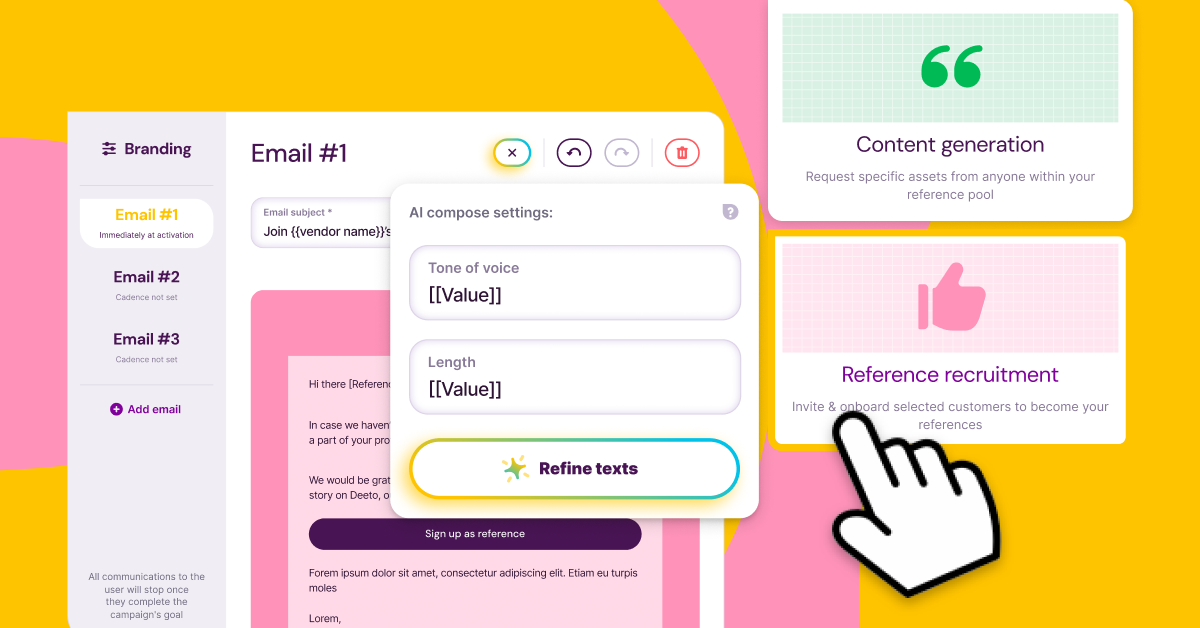
CRM is the core system your sales force will be working in. It handles just about everything:
It also integrates bi-directionally with all your other tools. For instance, when a lead comes through your marketing automation platform, it auto-syncs that info with your CRM as a contact record to follow up on.
Sales automation tools eliminate manual work from different aspects of the BDR and SDR workflow.
These are just a few examples of different tools with automation features that enhance your SDRs' and/or BDRs' productivity.
For instance, you can use Deeto to build personal mircosites for different kinds of prospects and increase top-of-funnel intent. Instead of sending a regular old email, you can send them a persona-based web page with relevant USPs and user-generated content.
Your tools are constantly collecting data from selling activities, customer engagement, and transactions.
CRM tells you everything you need to know about your pipeline and SDR/BDR performance. That includes things like:
Sales automation tools provide similar reporting but with a more granular level of detail.
You also have platforms like Deeto, which monitors opportunities and evaluates advocates' and references' impact on lead generation, opportunity progress, and conversions, and shows you which customer segments or industries are most likely to become advocates for your product.
Today, a significant majority of sales teams have integrated AI into their operations. Salesforce's sixth State of Sales report found that 81% of sales orgs are either testing or already using AI tools. McKinsey's global State of AI survey supports this, showing 78% of organizations use AI, with marketing and sales among the most common areas of application.
It's worked its way into just about every facet of the selling process:
Deeto's AI even analyzes a lead's profile and gives sellers personalized UGC and social proof. That way, reps have an easier time qualifying leads, and they share relevant content that addresses buyer pain points right off the bat.

While the role of the sales rep (BDR or SDR) is a critical one, the fact of the matter is that fewer and fewer buyers are interested in interacting with them. According to research from Gartner, 75% say they prefer a rep-free experience altogether.
The reason is that they prefer to do their own research — 85% of buyers trust customers in their industry more than any other source of information, and they've completed 70% of the decision-making process by the time they engage someone from the company.
Deeto facilitates a more customer-led sales process. You can use it to gather customer feedback and social proof, distribute it across your sales and marketing channels, build a reference pool, and match relevant customer experiences to target accounts.
Request a demo to see how it works.

Explore SDR vs. BDR roles: learn their distinct tasks, goals, & when to use each. Master sales strategies!
Thanks to generative AI, you can mass-produce virtually any type of content: blog posts, sales emails, even full-on case studies.
Now...solely relying on AI for customer engagement is a recipe for disaster. In 2023, 92% of companies said they use AI-driven personalization in marketing and sales, but the key word here is “driven.”
Those who use it successfully aren’t replacing their team with it — they’re using it to 10x their team’s productivity and deliver personalized experiences to more customers at once.
To successfully use AI in your sales, marketing, and customer success efforts, you have to know where you need that human touch, and how AI can supplement that.
According to McKinsey, nearly three-quarters of all customers expect companies to give personalized interactions. And for B2B buyers, 80% of them expect a B2C-like experience when it comes to personalized content and seamless interactions with your company.
Your team members are there to lay the groundwork:
It's on your sales team to build relationships with potential customers and convert them. And it's on your CS team to activate your cusotmer base and turn them into advocates. If you don't take the time to get to know your users, AI won't be able to bridge that gap.
B2B sales involve multiple decision-makers (all with different needs). They have long sales cycles that require a different approach at each stage, and negotiations are complicated.
Your sales team needs to know which content, customer references, and data points to use for each member of the buying group at each step of the process.
While AI can personalize content and suggestions based on data points, it can't replicate the human touch in one-on-one interactions. Your sales and CS teams have to be skilled at understanding the unique needs and preferences of each customer and tailor their interactions accordingly, and they need to be the final gatekeeper for any AI-generated content or recommendations.
AI isn't a replacement for marketers, sales reps, or CS managers. But, if you lay the foundation with quality data and a well-defined strategy, it’s the missing puzzle piece that'll help you understand your customers, simplify content creation and distribution, and scale your sales and marketing efforts.
You can use AI-powered software to collect information about your customers' firsthand experiences, preferences, and pain points with your product.
With Deeto, it's as easy as making an Instagram post. Just send them an invite to onboard themselves, and they'll set their contribution preferences.
By analyzing your customers’ contributions Deeto will provide an overview of their sentiments, in addition to consolidating all of their information in one place. From there, you can personalize your engagement strategy for at-risk customers, those with the highest engagement levels, and those who use a particular version of your product.
When it comes to integrating UGC into your sales process, the biggest challenge is going out and actually finding where that content is. If you use multiple platforms for things like product feedback and customer advocacy initiatives, nobody has the complete picture they need to authentically engage with customers.
With Deeto, your sales, marketing, CS, and product teams work from the same platform. It gives them a complete view of what customers are saying, what they’re doing, and how you can use that content and data to make more connections with people.
It also has strict guidelines for user ownership and content approvals, meaning your customers' data is safe and secure.
The other major challenge when it comes to distributing your marketing and sales collateral is the fact that every customer is different. They’ll have different use cases for your product.
Even within a buying group, two members will have different interests in the decision-making process. If you share the exact same social proof and UGC with everyone in your pipeline, you’ll quickly find it’s irrelevant to most.
AI, like Deeto’s, can assess a customer’s profile (company type, use case, etc.) and present sales reps with personalized UGC and social proof based on that assessment. Instead of sifting through a bunch of irrelevant content, they’ll be able to share content that speaks to their buyer’s use case and pain points, which drives deals forward significantly faster.
Your CRM has all your customers' purchase history, communication records, business or personal info, and more. Integrating it with your AI tools will help them create more accurate customer profiles, segment them, and run automation workflows that serve them the right content and offers.
When the two are connected, every activity in your customer knowledge system (e.g., a reference call) is instantly updated in your CRM, so everyone's on the same page.
Deeto handles the end-to-end process of activating your customer base and turning their insights into usable assets for your sales, marketing, CS, and product teams. Centralization and AI-powered insights make it easy to connect and communicate with prospects at scale in an authentic and data-driven way. Book a demo and see how it works.

Discover how AI personalization drives authentic marketing in today’s evolving digital landscape.

See how Deeto helps you turn customer voice into a GTM advantage.
© 2025 Deeto. All rights reserved.